#add on other common tumblr things
Text
.
#feeling simultaneously lonely for new friends while also being overwhelmed by your current friends sure is A FEELING#one friend is in an abusive situation and won't acknowledge it#and other than telling her to leave I can't support her bc she has a dog and my cats hate dogs#another friend is struggling with dating and I'm her biggest confidante which is fine but I worry for her too#I'm missing my home state friends and won't be seeing them til july#and only for a weekend#I miss having convenient friends that I can just see any time I want#I recently missed a friend who hasn't been my friend since 2016#I'm conflicted about whether I want to put in effort to foster fandom friendships because I've been burned one too many times#Sure we have one thing in common now but what if the one thing goes away#although let's be real I'm already emotionally invested bc that's just how I be ahahhahaha#excuse me tumblr#I was typing out I just want and it auto filled to be thin#I have had plenty of intrusive thoughts but not THAT one#anyways#I just want my mind to be quiet so maybe screaming into the void will help#also looking into getting an ADD diagnosis will probably help to#april cannot come soon enough#seiya rants
0 notes
Text
tumblr in reddit terms
blogs: personal subreddits where the theme/topic is 99% of the time just “me and whatever the hell i feel like at the moment”. for reference, the most common other theme rn is “wizard roleplay that never breaks character”
reblogs: crossposts. these are crucial to maintaining tumblr’s ecosystem. due to blogs generally having fewer followers than subreddits have subscribers, this is the way that posts get seen and passed around. the vast majority of posts on a person’s blog tend to be reblogs, so if the people you follow dont reblog a whole lot, your dashboard is gonna be a ghost town. post limit (combined total of reblogs and original posts per day) is 250, so feel free to go hog wild
tags: this one is complicated. theyre a combination of flairs and Comments But Low-key. you can use them for organization and to avoid seeing content you dont want to (go to your blog, settings, account settings, content you see, and then add tags you want tumblr to warn you about before seeing it). if op tags the post #reddit (in the tags, not the body of the post), itll show up in the #reddit tag when anyone searches that tag. tags are also used for comments that dont really add anything to the post. you know how a jpeg gets kinda gross when its been through a million screenshots and has ifunny watermarks and shit? thats what adding “lmao same” as a comment does to a post. comments stay on reblogs, while tags show up in 4 places: op’s notifications, the notifs of whoever you reblogged it from, when someone clicks on the “notes” button of a post and actively looks for the tags left on it, and when people view your specific reblog of the post (like a follower would on their dashboard)
likes: upvotes but weaker. almost everyone turns off all the algorithms (settings, account settings, dashboard preferences, toggle off the first 3 options. also, make sure your dashboard is on "following" and not "for you". this is highly recommended), so leaving a like doesnt boost the post in any way. they still matter to some people. you can also use them to bookmark a post and go back to your likes later
enthusiastic and/or hyperbolic tags: reddit gold. you wanna let op know you like their art? leave something like ”#printing this out and stapling it to my forehead #op you wanna get married?” in the tags
pornbots: both reddit and tumblr have an issue with them. we block and report them on sight. they usually have hot women as their icons, no posts or reblogs, and a description like “22, brazil, nurse <3″. try to not look like that if you dont wanna get blocked by everyone you follow
blocking: you have this as well, but it seems like a bigger deal on reddit. the reason we are not twitter is because we block bitches who annoy us and move on with our day. do not feed the trolls
things we dont have:
karma: clout-chasing is The Most embarrassing thing you can possibly do on this site. we are all in this circus together and the clown who gets the most laughs is still a clown. popular users will literally deactivate sometimes because clout is a burden. no one here makes money
1K notes
·
View notes
Note
heads up there are accounts on here within the cod fandom planning to mass report accounts that post dubcon/noncon fics. would be a shame to lose you to those losers
Yeah, I figured out that would happen eventually when I started getting weird comments and anonymous asks about my noncon stuff lmao mini rant ahead.
Whatever happens happens ig, I have my stuff backed up but it's annoying and discouraging to see people deciding to comment hate on dub-con/non-con fics as if there isn't a warning for that type of content on the beginning of every single dark fic I make. I've had people tell me I'm normalizing sexual assault/rape as if I'm not a victim myself, and that's mainly why I've stayed away from writing dark fics until lately.
The community can be exhausting, giving people the chance to remain anonymous and say all the stupid shit they want to say without any consequences to it. Can't even count the number of things I've deleted from my inbox and never bothered answering because they're simply weird, hateful, and just make me tired as hell.
It's insane how impossible it seems to be for people to simply scroll away when you see warnings of topics you don't like or that trigger you. Truly, it's as simple as blocking an account or dismissing the post, there are tags you can blacklist as well, so why does it seem so difficult to use common sense?
Anyway, just woke up and I'm exhausted. I'm going to be taking a small break from Tumblr and writing while I work on some other stuff and try to get inspiration for my fics<3 I love you guys, I've always been immensely thankful for the support I've gotten. We're at 4438 followers now, should get to 4500 by tomorrow. I'll come back with hopefully more original ideas and more practice!<3
If any of you guys would like to play MW2/MW3, hmu! andddd to my mutuals, if you wanna add me on discord lmk<3

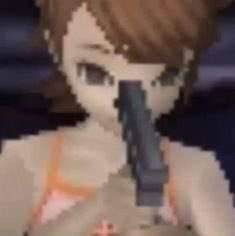

352 notes
·
View notes
Text
Etta's Guide to Writeblr (March 2023)
So you fled here from Twitter/TikTok... Where to start?
Welcome to Writeblr! Pull up a chair, open those documents, and pour yourself a cup of your favorite tea, coffee, or cocoa. The first thing you'll want to do is start following other writers. Check out this post for recommendations! Search through the notes to find hundreds more. Since I made that post, a bunch of people mentioned they're lurking and still trying to figure out tumblr, so I thought I'd make this post to help people get settled.
How to set up your blog
Make your blog name something not resembling a pornbot - it can be whatever you want, anything fun goes, just not [name###]. If you include "writer" or "author" somewhere in the url it makes it easier to spot writeblrs at a glance but it's not a requirement
Change your profile to something that's not the default, Make sure you have a blog title, and add a little description in your blog header if you feel like it!
Make a pinned post introducing yourself (pls don't use your real name or any IDing information for privacy's sake, this isn't facebook), a short summary of your WIPs, and links if you have an author's website/newsletter/ao3/etc. You can check my pinned post for an example
Make intro posts for each WIP! You can spruce these up with graphics (canva and unsplash are both great free resources to make edits/moodboards), excerpts, lists of tropes, character intros, etc. Link to the WIP intro in your pinned post so it's easy to find! You can update these as often as needed
If you want to make character intros, go wild. If you can't draw, piccrew is a great option. Just start talking about your WIP!
Come up with a tagging system to keep your blog organized. I recommend individual wip tags or at least one for your original writing in general so it's easy to search for your work on your blog
Keep track of Taglists for your WIPs. Whenever you post a new thing about your story, tag the people who asked to be notified to make sure they see it! Only tag people who ask to join the taglist, but it's a good way to keep track of interest. It's normal to have multiple taglists for each story+ one general writing taglist.
How to make writer friends
Reblog their work and add nice comments, either in the tags, comments, or the reblog itself People notice regulars in their notes and appreciate the attention. I promise it's not weird to compliment a total stranger
If that's too intimidating, community events are your friend!
Weekly Ask Games: These are weekly events that are loosely themed where writers send each other asks about their WIPs! The most common are Storyteller Saturday (about the writing process), Blorbsday (aka Blorbo Thursday about characters), and Worldbuilding Wednesday (about the setting of your story). If you answer these late, nobody really cares, but it's a fun way to receive prompts and learn more about other people's stories.
Ask Games/Memes: These are posts with lists of questions you can reblog from other people, sometimes themed or listed with emojis. It's common courtesy to send an ask from the list to the person you reblog it from, then people can send you questions as well, so you can talk about your stories! You can search for dozens of them
Tag games: There's a ton of different types of tag games, but basically someone @s you with a challenge/question, you reblog with your answer, and then @ a bunch of other people to continue the chain. Some common ones are Heads Up 7s Up (share the last 7 lines of your WIP), Last Line Tag (share the last line you wrote), and Find the Words (ctrl+f the given words in your doc and share the results, then give new words).
Formal events: These are community wide participation challenges organized by certain blogs! @writeblrsummerfest is every July?? August? I think? It's run by @abalonetea a few years strong, and there are daily prompts and ask games! @inklings-challenge is a month-long short story entry for Christian writeblrs. I think there was a valentines event in February. @moon-and-seraph is hosting a pitch week soon! Since these are more organized, it's very easy to find similar blogs and support!
Misc. Notes on using Tumblr
Follow the tags #writeblr and #writeblr community to find other writers, as well as other tags that interest you like #fantasy for example
If you want to bookmark a post to read later, you can like it and/or save it to your drafts
The queue/schedule function is very useful if you want to space out posts or have a backlog to keep your blog running when you get busy. This is good for the community because it gives older posts a chance to be rediscovered! You can change the posting frequency in the settings.
REBLOG YOUR OWN STUFF. People aren't always on at the same times and so it's the best way to account for people with different schedules and timezones. If you're worried about being annoying, you can tag those #self reblog or something similar and other people can filter the tag, but otherwise it's a welcomed and accepted practice.
If your excerpt is pretty long, put it under a cut. On desktop you can do this by selecting the squiggly button on the far right when you make a new paragraph, on mobile type :readmore: then hit enter.
It's polite to add descriptions to images and videos for visually or auditory impaired people. If you don't know how to write descriptions, here's a good resource
In your dashboard settings, it's best to shut off the options "Best Stuff First" and "Based on your Likes". These function as the website algorithm and suppresses the blogs you actually follow, which defeats the purpose of the site, letting the dash be in reverse chronological order. Also turn off Tumblr Live because it's malware as far as anyone's concerned.
Curate your experience, block the trolls, and be nice
Update for March 2024
How to shut off AI Scraping on your blog
Go to settings and find the Visibility tab
Scroll down to the tag that says "Prevent Third-Party Sharing"
Turn that knob over so that Automattic can't steal your work for their language training model databases >_<
The other settings will just hide your blog from search engines so they're useful for hiding from nosy parents or other Tumblr users but if you're trying to build an author platform you can leave them off.


Again, welcome to the community! I hope you have a ton of fun!
1K notes
·
View notes
Text
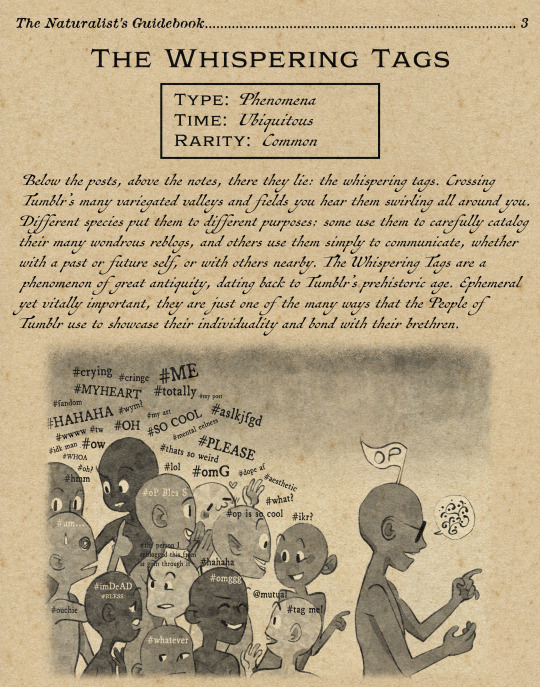

The Naturalist's Guidebook, Part 2
The Whispering Tags
TYPE: Phenomena
TIME: Ubiquitous
RARITY: Common
DESCRIPTION:
Below the posts, above the notes, there they lie: the whispering tags. Crossing Tumblr’s many variegated valleys and fields you hear them swirling all around you. Different species put them to different purposes: some use them to carefully catalog their many wondrous reblogs, and others use them simply to communicate, whether with a past or future self, or with others nearby. The Whispering Tags are a phenomenon of great antiquity, dating back to Tumblr’s prehistoric age. Ephemeral yet vitally important, they are just one of the many ways that the People of Tumblr use to showcase their individuality and bond with their brethren.
FIELD NOTES:
#it seems that with the introduction of the new twitter users that some whisperers are incorporating the 'prev tags' trend in earnest nowadays #along with tumblrs new inclusion of 'see all tags' option our normal hiding places are exposed and we have to be more mindful - @memesandthingsilike
#you do have to be careful #tags have a length limit #a single tag can only reach 140 characteres so you have to be careful not to go over #so whatever you're trying to say is not cut and lost into the blue void - @nightlocktime
#i use them both to categorize and organize things on my blog for easier searching#and to make additions to posts that don’t have to propogate beyond my own reblog#i even have a tag that i add to such additions: #talking tags #which makes it easy for me or anyone else to go read my thoughts that i chose to keep as whispers - @corvidinthewoodsds
Whispering tags can also inspire a conversation or the evolution of an idea. As people level their thoughts on an idea in the tag, the op may incorporate them later with credit to the whispering tags. - @karlyanalora
6K notes
·
View notes
Text
What is going on with cutting posts?
You may have seen some posts floating around lately about the beta editor and trimming reblogs, and possibly found yourself extremely confused trying to figure out what this tangled web of editors, extensions, and add-ons even means. I’ve been on this site for years, and I still find the whole thing terribly confusing.
So this post is my effort to explain everything -- legacy vs beta, New XKit vs XKit Rewritten, editable reblogs vs trim reblogs -- everything. This also doubles as a tutorial for the various methods of cutting posts.
TL;DR
Tumblr is in the process of switching to a new post editor that some old users have opted into, while new users have been forced into it.
The old Editable Reblogs extension does not work with this new editor, requiring people to use a new extension called Trim Reblogs.
Trim Reblogs and Editable Reblogs are not compatible. If your partner uses Editable Reblogs, you cannot cut their posts properly using Trim Reblogs (unless you’re willing to do some tedious and frankly unreasonable workarounds).
The only way for everyone in the RPC to cut their posts properly and efficiently is if everyone moves to the new system and uses Trim Reblogs. Clinging to the old system with Editable Reblogs is actively creating issues for the people using the new system -- some of whom do not have a choice.
Cutting Posts
Cutting posts is the act of removing older replies on a thread when reblogging it. This goes by several other terms, including trimming replies/reblogs or any variation of that wording, but I will be referring to it as cutting posts to avoid confusion with the Trim Reblogs extension, which will be coming up a lot.
Typically, when cutting a post, you only keep your latest reply and the reply from your partner that immediately precedes it. This means that instead of a thread looking like this...

It would like this:
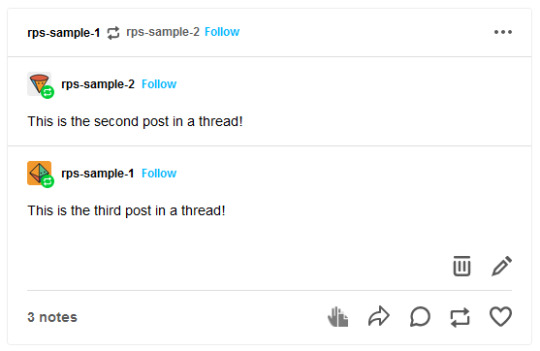
Or like this, depending on the method used:
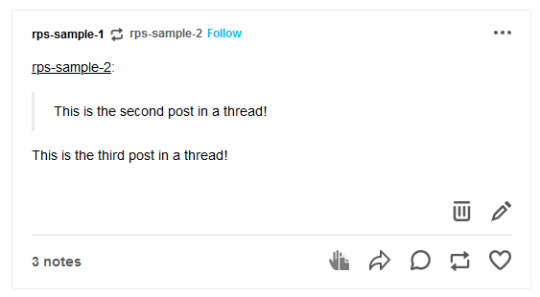
In either case, the first post is gone while the second and third post remain.
Cutting posts is done so that threads aren’t all extremely long on the dashboard. When there’s three short replies like this sample, it’s not that bad. But imagine a thread with twenty replies where each is several paragraphs long. That would require people to scroll and scroll and scroll to get past it. And since the same thread would be reblogged multiple times, your dash might become the same posts, over and over and over again, with only one new addition at the end each time.
Cutting posts is extremely common Tumblr RP etiquette. Many people won’t follow you if you don’t regularly cut replies, due to how irritating the alternative is.
Copy and Paste (Outdated)
Once upon a time, you used to be able to cut replies without any kind of extensions. Unfortunately, those days are gone.
That method worked as follows. You would go to reblog as usual...

Copy and paste the last reply, putting it in a blockquote (or using any other formatting you like, really), then add your own reply underneath.
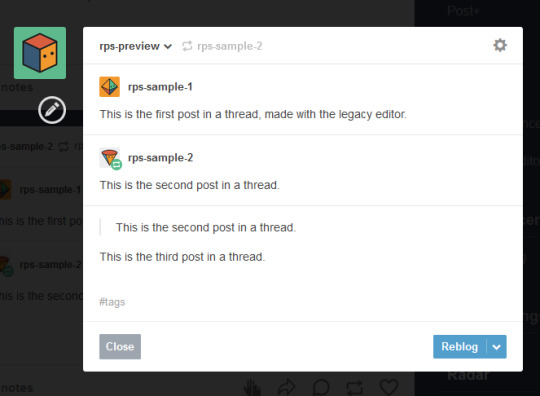
Then you can simply hover over the older replies and click the red X in order to remove them.

And this used to work. But now, the very first post in a thread cannot be deleted -- only later reblogs can. This means that the first post will always stay above the others, no matter how far along in the thread you are.
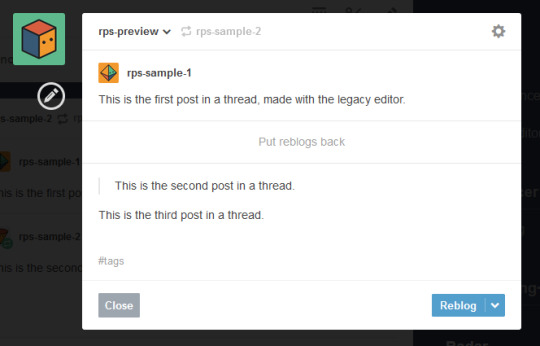
So since cutting posts can’t be done normally, we have to rely on browser extensions. This is where things get complicated. And also where I need to explain the different editors.
Legacy vs Beta Editor
Every time you make or reblog a post, you are using Tumblr’s post editor to do so. This is the area where you type up your post, add images, etc. Tumblr has been using the same editor for several years now, and it’s called the legacy editor.
However, Tumblr has been slowly rolling out a new text editor, called the beta editor. You may remember the beta editor when it was first rolled out a couple years ago as a buggy, unstable mess -- that’s not the case anymore, and it’s no more buggy than the current editor. For text posts, it’s functionally pretty similar, and even has a few features that some of you might want, such as easy colored text and the ability to make posts non-rebloggable. (Photo and other posts are fairly different, and I know gif makers have some pretty understandable reservations and complaints about it, but I won’t be covering that here.)
Older users have the option to toggle between the legacy and beta editors at will, while new users (starting around November/December 2022) are locked into the beta editor and cannot switch back to legacy.
To check which editor you have, go to make a new text post and look in the top right corner.
If you see either of these:


You are using the legacy editor, with the option to switch between the two.
If you see this:

You are using the beta editor, with the option to switch between the two.
If you don’t see anything at all, you are using the beta editor, and cannot switch.
While the text interface of the two editors isn’t terribly different for roleplay purposes, the methods by which you need to trim reblogs are entirely different. Each requires a different extension -- specifically, a different version of XKit.
XKit
XKit is a browser extension designed to add features and functionality to Tumblr. It includes many quality of life features such as a mutual checker, better tag tracking, queue improvements, ad blocking, more detailed timestamps, and so much more. (It was preceded by a similar extension called Missing E, if you’ve been here long enough to remember that.) And among all of these many features is the ability to cut replies.
The original XKit is no longer in use, having stopped updates in 2015 and being entirely unusable now. However, a few new versions of XKit have popped up throughout the years.
New XKit & Editable Reblogs
A different team created New XKit as a successor to the original, a similar extension designed to restore many of the same features.
New XKit’s feature to cut posts is called Editable Reblogs. It works by adding a pencil button to the left of the post when you reblog.

Clicking that button will break the post’s formatting -- actually changing it to how Tumblr posts used to be formatted -- but allow it to be edited however you wish.

So in this instance, I could simply select the first reply and delete it before adding my new reply underneath.
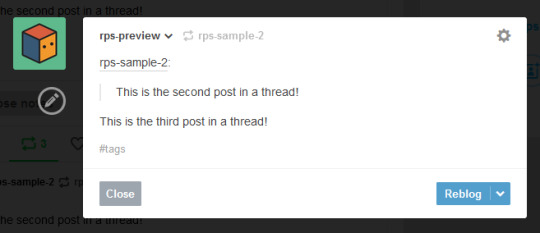
Editable Reblogs is only available if you use the legacy editor. It does not work with the beta editor and does not even appear as an option.
XKit Rewritten & Trim Reblogs
In 2020, Tumblr began to roll out its updated dashboard, which is now permanently in effect for all users. While the new interface looks very similar, the code was actually entirely redone, and behind the scenes functions very differently from the older dashboard. As a result, some of New XKit’s features no longer work as intended -- though a few still do, such as Editable Reblogs.
In response, the New XKit team decided to similarly start from scratch and created XKit Rewritten, another iteration of the add-on with similar features once more. However, not all New XKit features are available on XKit Rewritten, and vice versa. Many people are running both extensions simultaneously to take advantage of features on both.
XKit Rewritten’s feature to cut posts is called Trim Reblogs, and it works completely differently than Editable Reblogs. With this, you first need to save the thread to your drafts with your reply already written.

You’ll see a scissors icon appear along the bottom of the post. Clicking that will open the trimming options, letting you select which previous reblogs to delete.
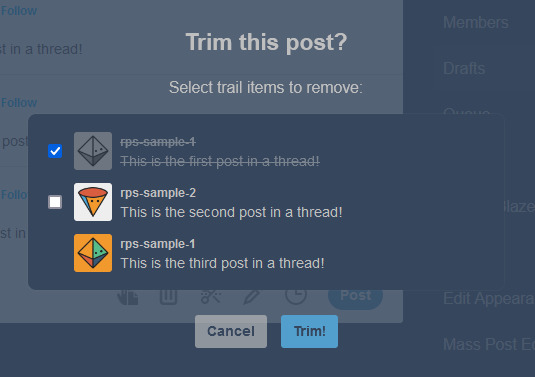
Clicking Trim will remove the selected reblogs.

You can then click post. You’ll note that this method preserves Tumblr’s formatting, as opposed to Editable Reblogs, which breaks it.
EDITED TO ADD: Apparently you don’t need to already have your reply written in your drafts anymore. You can save the post to your drafts without adding anything, use trim reblogs, then edit the post to add your reply. Either works fine.
This method does have two major issues, though. First, if the first post of a thread was created in the legacy editor, then the system gets really buggy and just doesn’t work.
This is what happened when I tried it out. Initially, it seemed to work as expected.
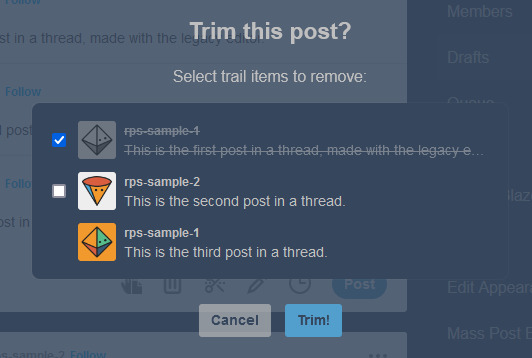

However, when I posted the reply, or simply refreshed my drafts, this happened.

Attempting to trim again simply caused this to repeat. There is no fix for this. This means that for this method to work, both you and your partners need to be using the beta editor.
EDITED TO ADD: You can fix this double posting by either using trim reblogs before adding your reply, or by adding your reply, using trim reblogs as intended, refreshing your drafts, editing the post, and clicking the red X to remove the first of the double postings. I have a better guide here.
The only other alternative is to move the thread to a fresh post when you reply, so that the new first post was made with the beta editor. Then you can cut future reblogs of the post using Trim Reblogs as normal.
However, the other major issue is that if your partner uses Editable Reblogs, you cannot use Trim Reblogs as intended. Let me show you why.
Say I want to reply to this post.

I’ll add my reply and save it to my drafts, as before.

You may have spotted the issue already. The first and second replies are now “combined” so that Tumblr sees them as a single post. We want the post to be interpreted like this, so that I can remove the oldest reply while still keeping the one immediately prior to mine.
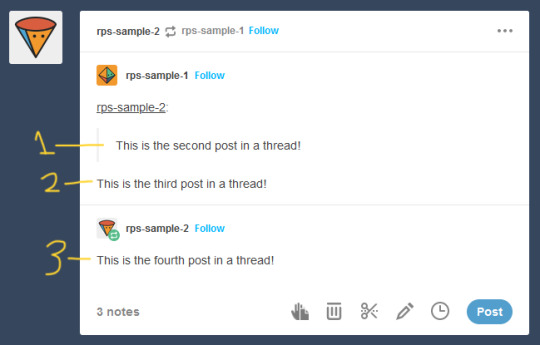
But Trim Reblogs can only see it like this.

When I go to trim reblogs, I can only remove the previous replies as an entire unit. I can’t remove just the oldest reply and keep the one immediately prior -- either it all stays or it all goes.

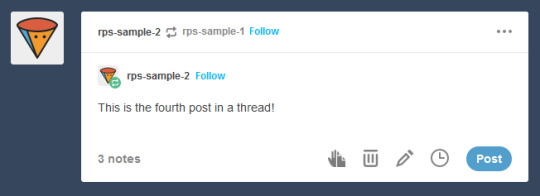
This is admittedly better than nothing. However, most people do want to keep their partner’s previous reply for reference, and just to have on their blog. This means a lot of people using Trim Reblogs simply don’t cut their partner’s posts at all.
You might be able to get around this issue by combining it with the outdated cut and paste method I described above. When saving to your drafts, paste your partner’s last reply above your own, using a blockquote or whatever formatting you like to separate the two.
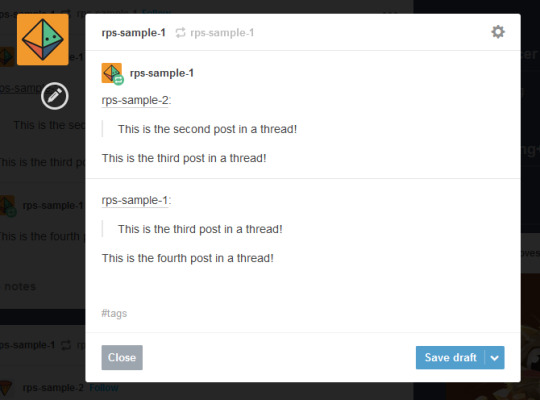
You can then use Trim Reblogs to remove the first post, leaving only your copy pasted reply. The formatting is broken, but it’s at least workable.

However, this will only work if the very first post of the thread was made with the beta editor -- since people using Editable Reblogs have to be using the legacy editor, you’re likely to still run into issues on a lot of posts. Which can again be solved by moving the thread to a fresh post made with the beta editor, but at this point we’re stacking so many issues on top of each other that I really can’t blame you if you just don’t want to bother with any of them.
All of this brings me to...
It’s time for the RPC to collectively switch to the new system
I’ve stuck to the legacy editor myself due to the issues described above -- using Trim Reblogs when everyone else still uses Editable Reblogs is an enormous pain that I don’t want to deal with. Even as I make this post advocating for people to switch, I’m dreading actually doing it, because I know that most of my partners still use the old system and I will have nothing but headaches.
But the thing is, everyone refusing to switch is what’s creating the headaches in the first place. If we all moved to the new system together, these issues would simply disappear, and we would all be able to effortlessly cut our posts using Trim Reblogs without ever having to worry about it again.
The RPC needs to collectively make the switch, for two reasons.
First, Tumblr is going to switch everyone to beta eventually. Refusing to switch now is really just delaying the inevitable -- it’s not a question of if you’re going to be forced into the new system, but when. By switching now, you can go ahead and get used to it and start giving feedback to both Tumblr and the XKit Rewritten team if you find anything buggy or broken.
Second, as I said above, new users are locked into beta, with no option to switch back to legacy. Trim Reblogs is their only option for cutting posts -- and as long as most of their partners are using Editable Reblogs instead, they cannot cut their posts properly. Their only option is to use a series of increasingly ridiculous workarounds that most people won’t understand. The fact that it took me 1500 words just to explain everything should tell you how confusing the whole thing is -- you can’t be that surprised when a lot of people, upon realizing that they can’t cut posts without a whole lot of tedium, decide to just not bother cutting them at all. The best way for everyone to be able to cut their posts properly and efficiently is for everyone to be on the same system.
Yes, the beta editor is different. It has some weird quirks. It will be a bit of a learning curve to get used to a new system of replying to threads. But this is a change that’s going to happen eventually, and is a change that needs to happen for a lot of people to able to cut their posts properly.
(It’s also worth noting that -- assuming you still have the option to switch -- you may be able to toggle between the two systems during the adjustment period. I haven’t been able to test this yet, but I see no reason it wouldn’t work. Use Trim Reblogs whenever possible, and especially for the partners that have already made the switch. But when you get to a reply that it just won’t work for, toggle back to the legacy editor and use Editable Reblogs just for that thread. It’s a bit annoying, but it could be the middle ground needed to help people start making the switch. And once the majority of the RPC is on the new system, then this won’t be an issue anymore.)
#rph#rpt#rpc#editable reblogs#trim reblogs#*my stuff#*my tutorials#this started as a tutorial for cutting posts and led into something else lmao#beta editor
2K notes
·
View notes
Text
Pachycetinae: The Thick Whales
Oh look I'm way behind not only on my work with wikipedia but also in regards to summarizing it on tumblr. Good thing, three of the pages I've worked on these past few months can just be summed up in one post because they are all one family.
So Pachycetinae, at the most basic level, are basilosaurid archaeocetes, the group that famously includes Basilosaurus and Dorudon. Reason I've picked up the articles in addition to my usual croc work, basically a friend and I noticed how lacklustre many pages are and stupidly decided to start revising all of Cetacea (pray for me).
Currently theres two genera within the group. Pachycetus aka Platyosphys aka Basilotritus, which is a whole mess I will get into at the end for those interested, and Antaecetus, which I'll just call "the good one" for now. Among those are three species. Pachycetus paulsonii (or Basilotritus uheni) from continental Europe (Germany and Ukraine mostly), Pachycetus wardii (Eastern United Staates) and Antaecetus aithai (Morocco and Egypt)
Picture: Pachycetus and Antaecetus by Connor Ashbridge


So the hallmark of Pachycetines, as the name would suggest, is the fact that their skeletons are notably denser than that of other basilosaurids. The vertebrae, the most abundant material of these whales, are described as pachyostatic and osteosclerotic. The former effecitvely means that the dense cortical bone forms thickened layers, while the latter means that the cortical bone, already forming thickened layers, is furthermore denser than in other basilosaurids with less porosities. The densitiy is increased further by how the ribs attack to the vertebrae not through sinovial articulation but through cartilage, so adding even more weight to them. Overall this is at times compared to manatees, famous for their dense skeletons.
Pictured below, the currently best preserved pachycetine fossil, an individual of the genus Antaecetus from Morocco.

Now there are some interesting anatomical features to mention that either differ between species or just can't be compared. For example the American species of Pachycetus, P. wardii, shows a well developed innominate bone, basically the fused pelvic bones. This is curious as one would think of it as a more basal feature, with derived whales gradually reducing them. The skull is best preserved in Antaecetus and has a very narrow snout. One way to differentiate the two is by the teeth. Pachycetus has larger, more robust teeth while that of Antaecetus are way more gracile and is thought to have had a proportionally smaller skull (in addition to being smaller than Pachycetus in general).
All of this has some interesting implications for their ecology. For instance, why the hell are they so dense? Well its possible that they were shallow water animals using their weight as ballast, staying close to the ocean floor. This would definitely find some support in the types of environments they show up in, which tend to be shallow coastal waters. There are some Ukrainian localities that suggest deeper waters, but that has been interpreted as being the result of migration taking them out of their prefered habitat.
Now while pachycetines were probably powerful swimmers, their dense bones mean that they were pretty slow regardless. And to add insult to injury, they were anything but maneuverable. Remember those long transverse processes? Turns out having them extend over the majority of the vertebral body means theres very little space for muscles in between, which limits sideways movements.
From this one can guess that they weren't pursuit predators and needed to ambush their prey. What exactly that was has been inferred based on tooth wear. Basically, the teeth of Pachycetus show a lot of abrasion and wear, not dissimlar to what is seen in modern orcas that feed on sharks and rays. And low and behold, sharks are really common in the same strata that Pachycetus shows up in. Now since Antaecetus had way more gracile teeth, its thought that it probably fed on less well protected animals like squids and fish.
Below: Pachycetus/Basilotritus catching a fish by @knuppitalism-with-ue

The relationship between pachycetines and other basilosaurids is wonky, again no thanks due to Pachycetus itself being very poorly known. Some studies have suggested that they were a very early branching off-shoot, in part due to their prominent hip bones, but in the most recent study to include them, the description of Tutcetus, they surprisingly came out as not just the most derived basilosaurids but as the immediate sister group to Neoceti, which includes all modern whales. Regardless, in both instances they seem to clade closely with Supayacetus, a small basilosaurid from Peru.
And now for the part that is the most tedious. Taxonomy and history.
Remains of pachycetines have been known for a while and were first described as early as 1873 by Russian scientists. To put into perspective how old that is. The material's history in science predates both World Wars, the collapse of the Russian Empire and even the reign of Tsar Nicholas II. Now initially the idea was to name the animal Zeuglodon rossicum, but the person doing the actual describing changed that to Zeuglodon paulsonii reasoning that it would eventually be found outside of Russia (something that aged beautifully given that Ukraine would eventually become independent).
And this is where the confusion starts to unfold. Because at the same time people unearthed pachycetine fossils in Germany too, which would come be given the name Pachycetus (thick whale) and be established as two species. Pachycetus robustus and Pachycetus humilis, both thought to be baleen whales.
Pictured below: Pierre-Joseph van Beneden who coined Pachycetus and Johann Friedrich Brandt who described Zeuglodon paulsonii. Beneden easily has the better beard.
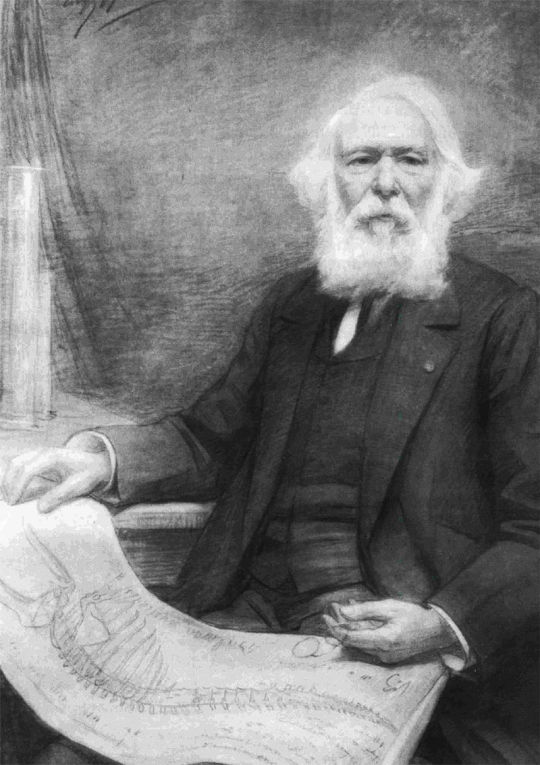

These latter two names however were later rejected in 1935 by Kuhn and lumped into other species, whereas Zeuglodon paulsonii was elevated to a full on new genus by Remington Kellogg in 1936. For those curious, Platyosphys means "broad loin", in combination with the species "Paulson's broad loin" to the amusement of some friends of mine.
And then people stopped caring and we have a nearly 70 year research gap. Eventually Mark D. Uhen found fossil material in the United States, but interpreted those fossils as being part of the genus Eocetus, naming them Eocetus wardii, a move that many following researchers disagreed with.
Then in 2001 a new species of Platyosphys, P. einori, was named. It's bad, moving on. More importantly, we got the works of Gol'din and Zvonok, who attempted to bring some clarity into the whole thing. To do so they rejected the name Platyosphys on account of the holotype having been lost sometime in WW2 and picked out much better fossil material to coin the genus Basilotritus ("the third king" in allusion to Basilosaurus "king lizard" and Basiloterus "the other king", isn't etymology fun?). They erected the type species Basilotritus uheni and then proclaimed Eocetus wardii to also belong into this genus, making it Basilotritus wardii.
This move was however not followed by other researchers. Gingerich and Zhouri maintained that regardless of being lost, Platyosphys is still valid and can be sufficiently diagnosed by the original drawings from the 19th and early 20th century. And to take a step further they added a new species, Platyosphys aithai (weird, why does that name sound familiar).
Then Van Vliet came and connected all these dots I've set up so far, noting that the fossils of Platyosphys are nearly identical to those of Pachycetus. This lead to the fun little thing were "paulsonii", applied first to Zeuglodon in the 1870s, takes priority over "robustus", coined just a few years later, BUT, the genus name Pachycetus easily predates Platyosphys by a good 60 years. Subsequently, the two were combined. Platyosphys paulsonii and Pachycetus robustus became Pachycetus paulsonii (simplified*). Van Vliet then deemed humilis to be some other whale and carried over Basilotritus uheni, Basilotritus wardii and Platyosphys aithai into the genus Pachycetus. *Technically Pachycetus robustus was tentatively kept as distinct only because of how poorly preserved it was, making comparisson not really possible.
Then finally in the most recent paper explicitly dealing with this group, Gingerich and Zhouri came back, killed off P. robustus for good, sunk Pachycetus uheni into Pachycetus paulsonii for good measure and decided to elevate Pachycetus aithai to genus status after finding a much better second skeleton, coining Antaecetus (after the giant of Greek myth).
And that's were we are right now. Three species in two genera, but only one of them is actually any good. So perhaps at some point in the future we might see some further revisions on that whole mess and who knows, perhaps Basilotritus makes a glorious comeback.
To conclude, sorry about the lack of images, despite the ample history theres just not much good material aside from that one Antaecetus fossil and I didn't want to include 5 different drawings in lateral view.
Obligatory Wikipedia links:
Pachycetinae - Wikipedia
Antaecetus - Wikipedia
Pachycetus - Wikipedia
Ideally Supayacetus will be the next whale I tackle, distractions and other projects not withstanding (who knows maybe I'll finally finish Quinkana)
#pachycetinae#pachycetus#basilotritus#platyosphys#antaecetus#archaeocete#prehistory#paleontology#palaeoblr#basilosauridae#eocene#whale
157 notes
·
View notes
Text
Writers: how did your main character feel in love
I been thinking about romance lately, and also how should I add some to my book. It always spices things up, how could I not! But the thing is, with that in mind, I became very intrigued about how other writers do it, specially how characters fall for one another in other stories. So, writers of Tumblr, tell me:
(I'm sorry if more than one apply! Also, if I forgot any recurrent trope/ situation where the characters get to know each other or fall in love, share it in the comments, I'd be very interested to know!!)
Otherwise, if none of this applies, I'm very curious! How did they fall in love??
Other ongoing writing polls
Goodbye and happy writing :)
#writeblr#writing#writer#writers#writers on tumblr#writerscommunity#writers of tumblr#current wip#main character#romance#oc#ocs#polls#tumblr polls
193 notes
·
View notes
Text
A Tumblr Quick Start Guide
A year ago, I realized that every time I logged onto Twitter, I felt my blood pressure rise. It's a platform that runs on anger and outrage, and I wanted someplace better to spend my screen time. In my almost-year on Tumblr, I now realize I log on here and get one or two good laughs every time I check my dashboard.
Tumblr has given me a lot lately, but it is a bit different than other platforms. I'd like to give back a little and provide a quick-start guide on how being new to Tumblr worked for me.
Finding Things to Follow
The biggest thing I had to get used to was realizing that on Tumblr, you don't necessarily follow people or celebrities or politicians. You follow your interests. In fact, it's pretty common to follow only strangers that post things you like. That can make your empty dash daunting to fill! Let's fill it with things you love and make you happy.
Make a list, mental or otherwise, of things you're interested in. Be both broad and specific! Board Games. Magic The Gathering. Supernatural. Marvel. Video Games. 8-Bit. Urban planning. Any and all things that you like!
Pick one of your interests and search for that tag. Flip between "Latest" and "Top" and browse around to see what kind of content is in that tag. You'll notice images, art, gif sets, TikToks, videos, essays - all sorts of things!
If you see a lot of things you like, cool! Click the button to Follow that tag if you want to keep up to date on it and find things later (we'll come back to this).
If you see a post you love, check out who posted or reblogged it. Scroll around on their blog. Do they post similar stuff? Are there other things you like here? Are they posting often? If you like what they post, follow the blog! Congrats, you've followed your first blog!
Take some time and check out some other tags and follow the same process - follow tags you like and blogs you might be interested in. It's not possible to over-follow! You can always curate your list later. This isn't Twitter - no one cares if you unfollow someone. Find what makes you happy.
Go back to your main dashboard - how are things looking? Filled with things you're interested in? Excellent. If things don't work for you, don't be afraid to unfollow blogs.
Want to follow more blogs? New episode of Andor drop? Go to the "Your Tags" header and scroll around to find some more juicy content. Check out blogs you like, follow 'em if you like em, rinse and repeat! That's curating your dash!
Your Blog is Your House
Okay, so you have a dashboard of content that you like - but what do you do with it all? Someone once described a Tumblr blog to me like your little house that you can fill with all the things you like. There is no rhyme or reason, and you don't need an excuse to reblog something other than the fact that you liked it!
If you see something you like, reblog it! To me, I reblog things when I say "I like this and I want it to live in my house so other people can see it when they come visit"
Reblogging is like passing a message along to other people. You can just reblog it on its own to amplify it, or you can add your own tags, or if you have a funny reaction gif/thought/video/thousand-word-essay, add to it when you reblog!
Use tags. People actually find posts through tags here. Use them to help people discover that really cool reblog you found! You can also search for tags on specific blogs. This makes them great for categorizing posts on your own blog. For example, I use #2022 Game Journal when I blog about whatever game I'm playing so I can do a year-end review later and find all the posts later.
Like things too. Likes don't amplify posts, but they're nice to let a poster know you appreciated it! I also use likes a bookmark. Sometimes I don't have time to watch that TikTok, so I'll like it as a reminder to come back to it later.
Be Weird. You can have sideblogs to hold more specific content, but don't be afraid to just scoop up anything you like and put it in your house! Reblogging is how content gets passed around.
Random Blog Tips
Wow nice job, your blog's looking great! Before you know it, someone will find it, check out your posts, and maybe give you a follow if they like what you've made or what your reblog! The last thing I'll touch on here are some nitty-gritty tips that can help you think about all the meta stuff about Tumblr:
Tumblr is the most anonymous social media platform. No one has to know who you are. Take advantage of all the privacy options.
You can also hide likes and who you follow from public view - that's no one else's business! Turn off asks too if you want.
Play around with your settings in general - there are lots of customization options and other dash tabs that you can use to find new content. You can also turn on timestamps so you know if a post you see is a "heritage post," as they say. Content is evergreen here and I personally like to see that in action.
You can filter and hide tags that you don't want to see.
Just block people liberally, it's cool.
You can pay to remove ads (nice), but you can also leave the option to see Blazed posts on. Blazed posts are ones that people pay for impressions for - and any post can be Blazed. The kicker is, there's no ad targeting. It can be quite funny or quite annoying depending on what you want.
When viewing the notes on a post, you'll see comments, reblogs, and likes. For the reblogs section, I like to filter by "Comments only" to find what people have added to the post.
Like all social media sites, there are dark corners here. I think Tumblr more than most puts you in control to curate your Dashboard to only see what you want. Block a user, hide a post, and move on.
That should be quite enough to get started! Tumblr can take a little more time to "get" compared to other social media platforms (and get in on the long-running jokes!), but trust me, after a week, you'll notice the difference between checking your Tumblr dashboard and checking your Twitter timeline.
Your blood pressure will thank you.
2K notes
·
View notes
Text
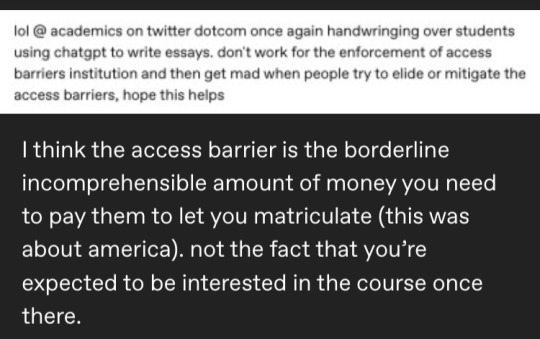
[ID: a tumblr post containing a screenshot. Text in the screenshot reads “lol @ academics on twitter dotcom once again handwringing over students using chatgpt to write essays. don’t work for the enforcement of access barriers institution and then get mad when people try to elide or mitigate the access barriers, hope this helps.” The OP of the post adds this commentary to their screenshot: “I think the access barrier is the borderline incomprehensible amount of money you need to pay them to let you matriculate (this was about america). not the fact that you’re expected to be interested in the course once there.” end ID]
some people are so allergic to questioning anything they consider to be “common sense” it’s pathetic. worshipping meritocracy and the supposedly automatically edifying qualities of “effort” and suffering while also proclaiming oneself to be some flavour of progressive. sheesh
also I know this isn’t the point but it never stops being fascinating to me that so many people with this “you need to learn to Be Literate In The Correct Ways, Which Is An Easy Thing That Anyone Can Easily Do” sort of attitude (the elision between “think in the incredibly specific way and write in the highly specific way required to complete an essay that adheres to this particular school of thought about what essays should be like” and “be interested in the course” is telling here) are also, like... not great at reading comprehension imo.
it was super clear, even just in this ungenerous cropping of a longer point, that the original post was (among other things) criticising academia as a whole for being intended to institute access barriers to accumulating wealth, prestige &c. such that skills the university considers necessary (& performance within the limits afforded by university disability ‘accommodations,’ which are a joke) are considered automatically necessary, unquestionable, unimpeachable &c. as though the academy and its conception of “literary” are natural and inherent facts of life, rather than representing a particular interpretation of which “skills” are needed and how those skills are evaluated based on what the institution of academia is intended to do, economically / politically / socially, within a given society (cf earlier discussions on my blog about the material circumstances under which the field of literary studies arises)
which is simply basic materialist analysis. but most people in the notes were again too busy being outraged at the people trying to “game” this already highly rigged system to be able to comprehend a criticism of the highly rigged nature of said system
337 notes
·
View notes
Text
what is (chronic) autistic catatonia?
// why specify “autistic” catatonia? //
catatonia most common associate with schizophrenia, but increase realize also happen in things like bipolar & depression.
if look at some of typical catatonia diagnostic criteria in DSM 5 (but in easier words): catalepsy & waxy flexibility, grimacing (hold same stiff facial movement), mutism, echolalia, echopraxia (copy movement), exaggerated mannerisms, stereotypies/repetitive movements, etc… wait! some of these things happen in autism!!! (like 7 out of total 12 can be seen in autism)
this is why important to know how recognize catatonia in autism. because overlap.
catatonia in schizophrenia most common start fast and get worse fast. but chronic autistic catatonia typically slow onset and slow but visible deterioration. (always have exceptions though)
not know a lot about schizophrenia catatonia, so this post largely focus on autism. everything below, when say “catatonia” or “autistic catatonia,” mean chronic autistic catatonia with deterioration.
// before move on— //
sometimes professionals do connect autistic shutdown with/as catatonia or catatonia episode or catatonia-like episode to draw connection. this not talk about that. this about chronic ones with deterioration. personally for community identity purpose i don’t enjoy (already have term for shutdown). but personal opinion aside, again this about the temporary vs long term all the time. if experience temporary shutdown, remember to leave space for and not same as those of us deal with chronic autistic catatonia.
important to distinguish from autism because autism and catatonia share many symptoms. (for example, physical stimming or “stereotypies” is autism diagnostic criteria AND catatonia criteria). autistic catatonia should only be suspected IF have new symptoms OR change in type & pattern of old symptoms. cannot. stress. this. enough. again. it not about IF you have these symptoms it’s about WHEN and HOW and CHANGE. it's about NEW.
and. please do not diagnose self based on one tumblr post. yes even if i do extensive research and cite sources and have lived experience. many many many disorders look similar. am all here for educated self diagnosis because medical system inequitable BUT am also sick of every time write this a bunch people comment “oh never heard this this is so me.” one tumblr post not educated self dx. it not a cool new thing to add to carrd to hoard as much medical label as can, it miserable it makes my life hell it not a joke it not cool. not every autistic have chronic catatonia, not every shutdown means chronic catatonia, even if you autistic and see these signs, may be separate unrelated disorder altogether, like Infectious, metabolic, endocrinological, neurological, autoimmune diseases, all can see catatonia (Dhossche et al, 2006). some of you all will read this and truly think this is answer been looking for so long—great! still, please do more research.
// chronic autistic catatonia with deterioration and breakdown //
the key defining symptoms of chronic autistic catatonia is gradual lose functioning and difficulty with voluntary movements (shah, 2019, p21). “gradual lose functioning” will come with regression in independence & ADLs & quality of life. it usually gradual, chronic, and complex. but can vary in severity. some need prompts on some day & some situations, while others need prompt and even physical assistance for almost everything.
how common? have seen statistic estimate from 10% - 20% of autistic people adolescents & above experience chronic autistic catatonia.
typical onset for autistic catatonia is adolescence. some study samples is 15-19, some as early as 13. some professionals think this autistic catatonia may be a reason for many autism late regression (Ghaziuddin, 2021).
can happen regardless of gender, IQ (yes shitty), “autism severity/functioning labels” (is what most studies use, so i keep, but yes have issues, probably also mean happens regardless of autism level 1/2/3 and support needs before catatonia, but need more research to confirm since these thing don’t equal eachother).
// primary symptoms //
from book "Catatonia, Shutdown and Breakdown in Autism: A Psycho-Ecological Approach" by dr amitta shah, recommend read at least first two chapter and appendix.
1. Increased slowness
often first sign but not always
periods of inactivity or immobility between actions which appears as slowness, e.g walking, responses (verbal & body), self care, mealtime, etc
2. Movement difficulties (freezing and getting stuck)
difficult initiate/start movement
freeze or become "stuck" in middle of activity for few seconds to minutes
hesitate & "to and fro" movements
difficulty cross threshold/transitions like door way
difficulty stop action/movement once started
affect speech content, fluency, & volume
eat & drink difficult (like movement for fork & knife, chewing and swallowing, etc)
spend long time in one place
(new) ritualistic behaviors
3. Movement abnormalities
repetitive movements like in tourette's & parkinsons
e.g. sudden jerky movement, tremors, involuntary movements, blinking, grimacing, unusual & uncomfortable postures, locked in postures, increase in repetitive movements, etc.
4. Prompt dependence
may not be able to do some or any movement/activity, unable to move from one place to another, unable to change posture, etc without external/outside prompt
5. Passivity and apparent lack of motivation
look unmotivated & unwilling to do stuff, include activities used to like, probably because can't do voluntary action or have trouble with request and make decison.
6. Posturing
classic catatonia symptom of being stuck in one posture, sometimes for hours
7. Periods of shutdown
8. Catatonic excitement
episodic & short lasting
e.g. uncontrollable & frenzied movement and vocalizations, sensory/perceptual distortions, aggressive & destructive outbursts that not like self
9. Fluctuations of difficulty
e.g. some days better can do more need less prompt! other days worse. sometimes emergency can act as almost like a prompt! but fluctuate doesn't mean difficulty voluntary
// secondary difficulties //
Social withdrawal and communication problems
Decline in self-help skills
Incontinence
‘Challenging’ behavior
Mobility and muscle wastage
Physical problems
Breakdown
// autism breakdown //
can be in addition to autistic catatonia. can look like autism is getting worse, even though autism by itself not progressive disorder!
i also call this autism late regression. separate between autistic catatonia & this not very clear, not enough research.
1. exacerbation of autism
1a. increased social withdrawl, isolation, avoidance of social situations
1b. increased communication difficulties
1c. increased repetitive and ritualistic behavior
2. decrease in tolerance & resilience
easily disturbed, irratable, angry
3. increase in "challenging" behaviors
e.g. self injurious behaviors
4. decrease in concentration & focus
5. decrease in engagement & enjoyment
// treatment //
for catatonia (autistic or not), typical treatment is lorazepam and/or ECT.
specific to catatonia in autism, Dhossche et al. (2006) separate it to mild/moderate/severe and give recommend treatment according to that (do not come here and argue about severity labels, because fuck! mild depression and severe depression of course have different suggested treatments and severity important to know. Remember we talk about autistic catatonia).
note: this is one paper! not the only way! yes have problems like most psych/autism papers, just here to give example (of range of symptoms and treatment route!). NOT MEDICAL ADVICE. (not even endorsement)
mild: slight impairment in social & job things without limit efficiency as a whole (essentially still able to function for most part but difficult).
moderate: more obvious struggles in all areas, but ambulatory and don't need acute medical services for feeding or vitals
severe: typically medical emergency, acute stupor, immobility for most of day, bedridden, need other people help feed. also malignant catatonia which can be life-threatening (fever, altered consciousness, stupor, and autonomic instability as evidenced by lability of blood pressure, tachycardia, vasoconstriction, and diaphoresis, whatever any of that means)
the "shaw-wing approach": very brief summary, keep person active and do thing they enjoy, use verbal & gentle physical prompts, have structure & routine.
lorazopem challenge: take 2-4 mg of lorazopem to see changes in next 2-5 minutes. if no change, another 1 mg and reassess
lorazopem trial up to 24 mg. (note difference between challenge & trial)
bilateral ECT, last resort.
mild: "shaw-wing approach" -> 2 week lorazopem trial if no imporvement in 1 month -> if effective, do both, if not, just shaw-wing approach
moderate: depends on prefernece, either shaw-wing alone or shaw-wing and 2 week lorazopem trial -> if not effective, do 2 week lorazopem trial if havent already -> if not, bilateral ECT
severe: lorazepam challenge test -> if not effective, bilateral ECT; -> if lorazopem challange positive, 1 week lorazopem trial -> continue if successful, bilateral ECT if not.
can sound extreme, but rememeber for many severe catatonia (autistic or not), it is medical emergency. can be life-threatening. there's no/not a lot of time.
it possible to make partial recovery, as in get better but not to before catatonia. but overall, many permanently lose previous level of functioning.
references
Dhossche, D. M., Shah, A., & Wing, L. (2006). Blueprints for the assessment, treatment, and future study of Catatonia in autism spectrum disorders. International Review of Neurobiology, 267–284. https://doi.org/10.1016/s0074-7742(05)72016-x
Ghaziuddin, M. (2021). Catatonia: A common cause of late regression in autism. Frontiers in Psychiatry, 12. https://doi.org/10.3389/fpsyt.2021.674009
Ghaziuddin, M., Quinlan, P., & Ghaziuddin, N. (2005). Catatonia in autism: A distinct subtype? Journal of Intellectual Disability Research, 49(1), 102–105. https://doi.org/10.1111/j.1365-2788.2005.00666.x
Shah, A. (2019). Catatonia, shutdown and breakdown in autism: A psycho-ecological approach. Jessica Kingsley Publishers.
#autistic catatonia#actuallyautistic#actually autistic#autism#autistic#long post#catatonia#loaf screm
690 notes
·
View notes
Note
THANK YLU SO MUCH OH MY WORD????? I actually feel like I understand all of this now… thank you for going through it so thoroughly, that’s so nice of you oh my gosh🥺
Also yeah Firefox rules— but… ahsjshdh again, weird question, any particular extension you’d recommend (other than uBlock origin)? I’ve seen people say you should keep extensions to a minimum as to not make your browser fingerprint super unique or something? But blocking cookies does sound cool, and I also didn’t know you could do that w/ extensions? I’ll leave you alone now I promise😭
you're welcome! i can't believe i've become one of the obnoxious Linux evangelists, but much like Tumblr, it's become the least-bad OS left standing just by continuing to get minor quality-of-life improvements while its competitors race to make themselves annoying to the point of unusability.
so the thing about browser fingerprinting is 1. it's less common than abuse of tracking cookies, and exists partially as a fallback to keep tracking you even when you're blocking the easier methods, 2. Firefox now does its best to block it, 3. if you're using Firefox on a desktop Linux computer, that is probably much more identifying in and of itself than any given combination of popular extensions. i've pretty much embraced privacy nihilism on that particular issue.
you still want to be choosy about your add-ons, though, because they can see and manipulate pretty much everything you do in your browser, and malicious ones can really fuck your shit up. uBlock Origin is maybe the most trusted adblocker out there, Multi-Account Container tabs is developed by Mozilla itself, and Privacy Badger is an EFF project, so i have no qualms recommending any of them. personally i run a few more on top of that: Decentraleyes and ClearURLs to mop up a couple more kinds of tracking crud; separate extensions to force all Amazon/Facebook/etc browsing to be quarantined in dedicated containers; a password manager; and just for the sake of fun & minor website tinkering, Tampermonkey and XKit Rewritten. your mileage may vary on the risks vs. benefits; useful and popular browser add-ons have been taken over in the past by bad actors.
i'm definitely not claiming this add-on stack is a cure-all for anything, because there's no way to fully escape the data parasites while still existing in society. it does, however, noticeably increase my level of peace and fucking quiet on the interweb, as well as affording me the petty satisfaction of making their jobs more difficult.
291 notes
·
View notes
Text
Limbus Company and its visual portrayal of female characters, an essay
Limbus Company, and by extent, Project Moon has been a great example of how female characters are visually portrayed. In this article, I’ll try to dissect why and how, focusing on Limbus Company as it has by far the largest amount of images I can talk about. Let’s dive in.
Disclaimer: I'm by no means a professional so please, PLEASE don't clown on this i.e mention the summer controversy. I have a personal trauma on that and do not wish to revisit it. I know it's practically impossible to ask from tumblr, but still.
Visually portraying a subject
Where to start? At the very beginning, of course. Portraying a subject visually (not talking about female characters in specific yet) has a number of things attached to it. Perhaps the first question one can ask themselves is this:
Where do I want the focus to be?
Now, you can be short and say ‘the subject, of course’, but even then, that won’t often be precise enough. Let’s say you have a butterfly as your subject. Do you want the focus to be on its beautiful wings? Or its curious multi-faceted eyes, or its roll-up tongue? What do you want the viewer to notice immediately?
Arguably, even photos of landscapes have at least one point of focus. The pretty waterfall, the vast mountains, the green pastures or the starry sky. Some have the focus split up in two, where both the lake and the mountains are to be spotted immediately.
How focus can be created
There are multiple ways focus can be drawn to a specific part or to a specific subject.
One way is to simply make everything but your point of focus uninteresting. A common effect used is the Bokeh, which blurs out the background so that it will automatically appear as less interesting and more as a faded bunch of colors that contrasts with the point of focus which is sharply shot in HD. You can also make the background to be a flat color, like black or white. Some pieces of art additionally add colored shapes or lines behind the subject as to accentuate it further.
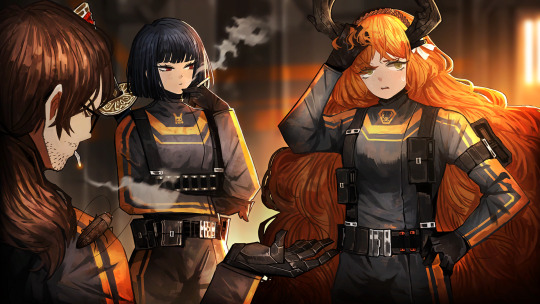
(an example of Bokeh. In addition, the direction in which another character looks shows what our main subject is, who is actually positioned off-center.)
You can also just…fill the space with the subject, as in a close-up of the thing in question. Following the previous butterfly example, it’s like only showing a small part of its wings, enlarged to comparatively huge proportions. This is also seen in portraits and to a lesser extent, similar art like waist-ups.

The eye is immediately drawn to what we should look at, which is the character who’s front and center in the image. Secondarily the blood. Her hair also uses the next point below: color.
If you’re working with color, then color is an excellent way to bring the focus to a subject. Bright colors and contrasts can be used, like what’s done here:
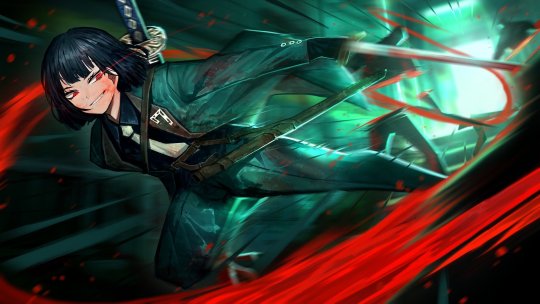
The bright red forms a direct contrast to the green that dominates the color pallette. It thus leads the eye to the red areas - aka the blood the character is spilling as well as her face, which is technically a tint of red. The red returning in her eyes which have a small trail, and on her bloodied face, as well as the yellow of her tie, further help to bring focus to her face and her expression. (Other than that, this image also has classic cartoon speed lines, which are minor but do help).
Light is also something I should mention. Using the image from above, the character is actually rushing towards the darker areas of the image. The light is coming from where she seemed to come from, judging by the speed lines and the trail of red we just saw in all its glory. The light forms a line around the subject which keeps said subject’s green uniform from blending into the darkness and the green of the image.
There is a specific technique called chiaroscuro (lit. ‘light-dark’) which is totally a real thing that even old masters like Rembrandt have used to bring focus. The gist of it is that the painting has very bright areas which is the subject, surrounded by dark areas, with not much in between. This technique is often used to make scenes more dramatic, and to immediately show us what the artist wants us to see, without any possible doubt. It’s like putting a spotlight on your head in a dark room. Chiaroscuro is also seen in Limbus:
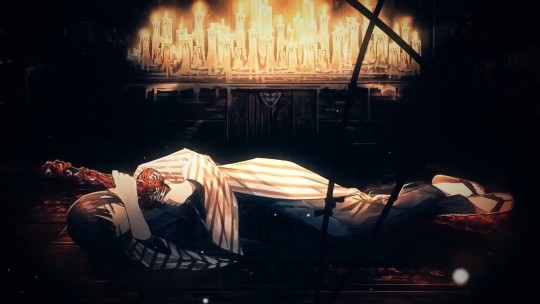
You can’t actually see much of the room our subject is in. The only light is coming from the candles, illuminating the top part of our subject. The other, darker half is much harder to see the details of. This makes it so that the eye is led from either the character towards the source of the light (the candles) or in reverse, both of which are possible and valid because in both cases, we ignore the pitch black part of the artwork.
How to create focus with characters (in specific)
Now, humans and humanoids are fascinating subjects to focus on, because there are so many situations a person can be in, and so much stuff a person can be. Are they the commander of a spaceship? A medieval ruler? An overworked office clerk? There are specific things that more or less pertain to humanoid characters more. I’m going into two aspects, clothing and posing - I’m aware there’s more, but for the sake of making this not longer than it is I’m going into only those two.
1. Clothing
What someone wears makes up a considerable part of how they’re seen and what they are presumed to be. This is also a large part of stereotyping. If you're wearing a t-shirt with pants, sunglasses, and have a camera around your neck, chances are people think you’re a tourist. To them, it likely won’t matter if you are, they will perceive you as one anyway. This is also important here: you might want to pretend you don’t know anything about the portrayed character or show their image to an unknowing friend and see what they think that the character is.
And that brings me to this point that I have seen so many times with female characters: their description/role not directly matching with how they are supposed to look if that were true. I’m talking about the battle-hardened veteran without muscles or scars of both kinds (even if adequate healing/scar removal is available in the setting). I’m talking about the scientist with a leotard under their lab coat. However, I’m not saying they should look a certain way or be the same - that’d be boring - I’m saying that…hey, it might make the viewer not take the character as serious as you want them to be.
The way clothing is built up can also serve as a way to bring focus to a specific aspect. Which will most often be either the boobs or the butt (or both) in the case of female characters. Look at this (non-Project Moon) example.

The woman in the front (obviously the focus due to the place she is standing in being squarely in the middle, and her red hair standing out) is the leader of that squad…as well as the strongest in battle. Without any protection of vital organs. With a shape under her boobs that would stab her fatally in the liver if she does as little as bend over.
The way her clothing is built up also brings the focus to her boobs - not only with how they’re prominently on display, but also with the shape the top and the fabric covering her shoulders makes. In a similar vein, her ‘pants’ and the belt all lead the eye downwards to her crotch as well. Furthermore, her thigh highs look skin-tight, bringing secondary focus to her legs, of course.
And last but not least. The guys behind her are actually properly armored from the neck down, making them somewhat more of a homogenous whole… in theory. The different body types, hair, and colors of the armor of the right and left dude make them stand out slightly more, which in turn only accentuates this ridiculous difference.
I don’t really have many Project Moon-originating images on hand that are similar to this. Every time we’ve had an ID with a female character being the leader of their group (of which we’ve had surprisingly many, actually - Don has two Section Director IDs to boot) they have usually been posing alone, or well, posing…their full uptie art normally shows a moment when they’re beating their enemy into a pulp instead of posing for the camera like in the above image. This is really consistent with the other half of the playable characters, who are male.
I want to give a special mention to two characters despite that. Faust and Rodion are both known as the more well-endowed characters, but from their IDs and E.G.O it is treated as something that’s there rather than something to be exploited.
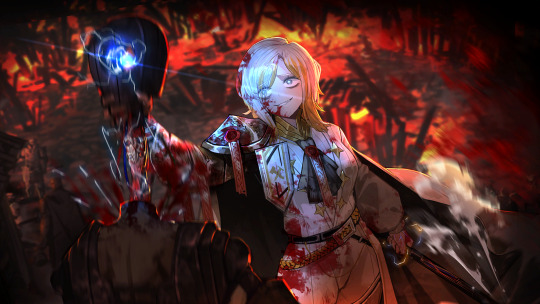
The blue glint is the highlight here, illuminating her blood-stained clothing but also finding its equal in her small, blue eyes. I have found eyes like this and expressions like this to be quite rare on female characters. Just look at her and her face. She’s completely lost it, wrapped in twisted and warped euphoria of the moment of ‘purging’ another ‘heretic’ - and from the looks of it, the last one on the scene. She’s not even trying to clean her own clothing or face, or expose her boobs. That’s not what matters to her image, showing any kind of skin doesn’t add to her character. She’s caught in this violent moment, having her victim completely in her literal grip - not even her eyes are looking at the camera. This image showcases the violent and sadistic nature of the character.

I find this art to be a curious thing. The background is actually rather bright, making the inverse true: the character is dressed in dark clothing, so that’s what the focus is on instead. Her coat flared out in such a way it can almost be mistaken for the underside of her long hair, making her seem even larger (something certain animals use when threatened to scare others into leaving). Her actual figure is thus more obscured, it only being a few tones darker. The thing that keeps her from being a dark blob in the foreground is her sword, large enough to be an odachi. Because she’s unsheathing it, the glint that comes from the blade immediately draws attention - arguably away from her partially unbuttoned top. The animation of this in the game supports this: no boob jiggle, just her standing calmly in the moment she’s just about to unsheathe her sword.
Because I’m going to use this example further in this thing, keep this one on hand.

An image that’s again in the middle of the action. Rosespanner Workshop Director Rodion is right now turning an enemy into an unrecognizable stain on the pavement with her huge weapon. The highlight is her weapon again, but this time it actually serves as a secondary source of light, illuminating her face. The yellow coloration of this secondary light source also makes the whole thing more interesting than if it just had the background light that serves a similar purpose as it did in the first image of this post. Even though the image has a heavy pinkish tint, the red that splatters all over the scene is still very much present and they draw the eye back to the yellow light. While her pose is ambiguous, it keeps things vague by not putting any sort of focus on her lower body. In any other piece of media this pose would be viewed from another angle, as to profit from as much of her body’s curves. Not here. Her killing an enemy with visible ease is important. Not her pose. This sounds logical, doesn’t it?
2. Posing
Which brings me to this. The way a character is posed also plays a part in their portrayal. It is possible to accentuate certain body parts with this - like when a character brings their hand to their chin, or the way their legs are posed. No matter the actual scene that’s meant, the way the character is posed is a factor that decides how it’s viewed and where the focus lies. Most often I’ve found this to be when a character is shown wielding a weapon, but their ‘battle pose’ being rather something that accentuates their bare skin, or their little clothing that does the same thing.
Is your character actually showing that they’re dangerous through being shown fighting…or are they just sexily posing with a weapon in their hands to add a sense of ‘danger’? Some can be highly difficult to distinguish. Some CGs can show the middle of the action yet the way the character is posed still brings the focus away from the violence or brings a secondary focus to it. Unfortunately I don’t have examples of those on hand but I know they exist.
A character just posing with a weapon isn’t wrong - I draw that all the time - but when the focus is brought to a character’s boobs and/or butt with the pose the character is in, it will be kind of obvious (even if it isn’t true) that sexualizing those features of the character what the artist is really intending to do instead of showing how dangerous she is with the weapon.
I’m going to use this image from Echocalypse as an example. I regularly take poses like this as a reference point and then attempt to make them more realistic, or, funnily, point out their weirdness by putting a male character in it. Often I do this by using them for a different, more appropriately clothed character. This goes to show that clothing can already decide a lot in posing itself.
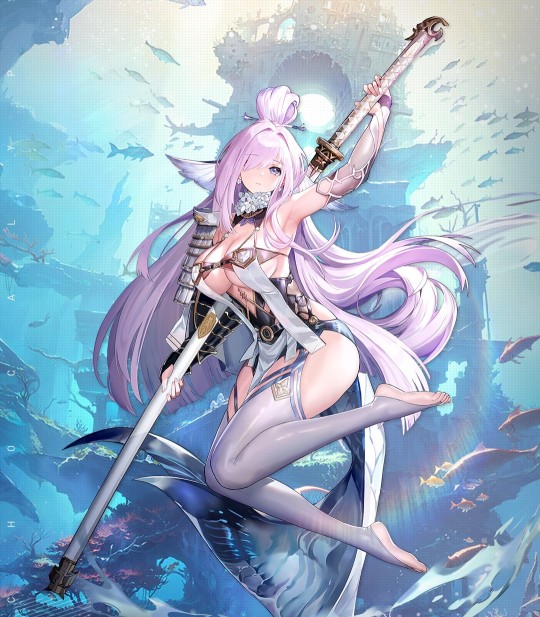
This character is posing with a weapon, a…particularly huge odachi in this case (I thought it was a staff at first until I saw the hilt). Which is exactly the same what Rodion is doing up there in the image we already handled. Yet, there are subtle differences between that image and this one, and it’s actually more minor than you think it is (disregarding the thematics of the pieces). Both characters…
are posing with an odachi of similar size (assuming that both characters are of similar height for ease of comparison) as opposed to being locked in battle; theoretically making the focus more on how pretty they look
have long hair (that, minus the bun and the bangs, have a similar cut) that makes their silhouette appear larger than it is
do have a relatively bright and sort-of detailed background going on
have large boobs
are unsheathing their weapon just slightly
However, to get to our first difference, we need to get back to point 1: clothing. Using the same two images, the largest difference is clothing. Kurokumo Rodion is wearing all-black clothing that covers her from the head down except for the unbuttoned top. If I had to describe what the other girl is wearing, I’d say she’s wearing a piece of armor on one of her arms, a flowered collar, thigh highs but no footwear otherwise, and something…obviously lingerie/bikini derived. I’m actually not sure if that’s a tail or part of the clothing.
But to return to our point: posing. The pose of Kurokumo Rodion is actually fairly neutral. She’s just standing there, menacingly! (I should note that their normal character talksprites are also just standing there neutrally) No, literally. Anyone with working legs and arms, can reproduce that. Just give them a sword prop and you’re done. Coat cape optional. The way she is standing does convey some sort of subtle confidence, however, just like the way she is actually looking down (at the viewer). It’s likely you’ll see the sword first for the reasons I mentioned when first discussing the piece above and then look at her from top to bottom as usual.
The way our other girl is posed…is a little harder to replicate in real life to say the least. Not only is this a floating pose (i.e you’d need support), the way her body is bent sharply brings the focus upon her boobs and butt. The human body is actually rather flexible, depending on how you’re built of course, but even so I do doubt whether anyone can do this pose even if they could somehow float in mid-air. Or do this lying down. I (someone with joints that are a little too flexible for my own good) haven’t tried and highkey don’t want to. The thigh and upper leg that is prominently on display, along with the way her body curves leads the eye to her butt or downwards towards her legs and feet.
Her facial expression is neutral, but I get some sort of… ‘dreamy’ vibe from it from the traditional anime-like proportions (huge eyes, tiny nose and mouth). Almost as if she’s doing puppy-eyes to beg for candy or something. It’s, well, what most people call to be a ‘babyface’. Kurokumo Rodion is also in ‘anime-style’ and her facial proportions are still a little bit unrealistic, but I do dare to say they’re more realistic than those of the other girl.
Also, small sidepath. What do you think the second girl is based off? One would judge from her tail that it must be some sort of water creature but whether she’s a shark or any other kind of sea creature isn’t really obvious. Would it surprise you if I told you she’s based on a bake-kujira, a SKELETON-whale (which sounds cool as all hell)? Without any kind of skeleton-parts worked into her design? To be fair, I wouldn’t have guessed it either if it were not for her canonical description.
Also, one last note about that latter image. I think that an odachi of that format would be extremely tricky to unsheathe in such a pose, because of the distance between your arms. Her arm that actually unsheathes the thing is also obviously reaching out, so she’d need more strength to do that than what the look of her arms suggest.
Speaking about arms…
On paper, our Limbus girls would have all the reason to have twig arms. After all, the City allows one to get stronger without visually changing their physique much. One can carry around huge weapons like chainsaws, lances and zweihanders without visible muscles. And yet. And yet.
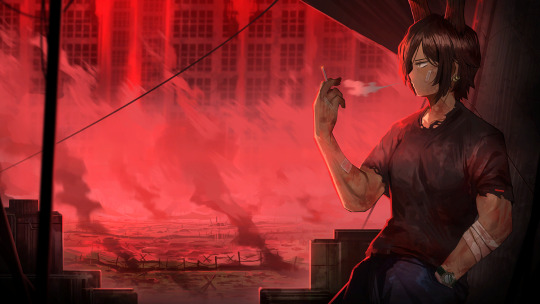
One of the few times bare arms are seen (most art prefers to cover them up - for Limbus standards, this would be the ultimate fanservice thing), it becomes very clear that they at least have a basic tone. Like, the basicest of basic efforts is done to make them not look malnourished. Even if this girl above is not like, the strongest of the world (for as far as we know...) the muscles she does have are very lovingly shaded and detailed.
To end this, I’ll showcase something one last time with a funny in-game example: Roseate Desire. Roseate Desire is an E.G.O which wraps the wearer in pink ribbons and is highly implied to especially speak to the sin of Lust (which is the affinity of the attack). In the game, this E.G.O is given to two characters, a girl and a guy. In any other gacha game, it would only be given to girls.
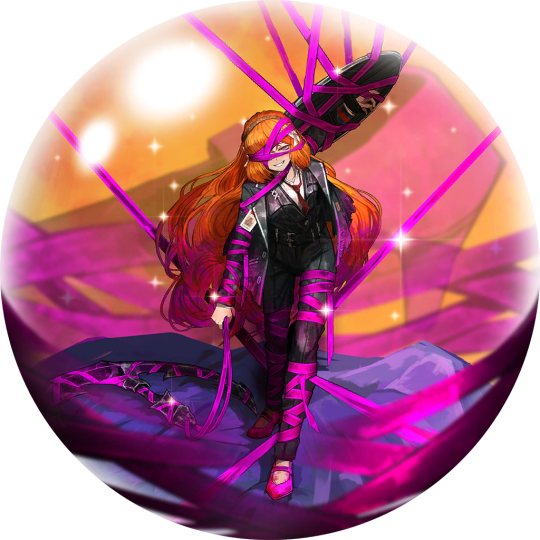
While bent over and with a happy expression, she’s still coming to get you. How can you tell? For one, the huge anchor she has with her is within her hand (i.e opposed to it being tied up next to her or something like that), and the shield that’s tied to her arm. Despite being wrapped up, she does still look as if a portion of her is still in control, and her attack suggests the same.

Hong Lu wearing it always makes me grin. He does wear clawed gloves and his fingers are arched, that’s true, but the way he’s strung up like a puppet makes it so that he can’t even get you with those. The manner in which he is posed and his head is tilted is highly reminiscent of how one would pose a marionette. And ingame properly he doesn’t even use these claws in close combat! He wraps up the enemy in the pink ribbons with doll-like movement. Even the way he’s covered evokes a sense of powerlessness, like he’s led on by the ribbons instead of controlling them.
I think this example, along with the others, is implicative of how Project Moon’s visual portrayal of female characters is done so well. They’re equally portrayed as the male characters, if not arguably more powerful, and there’s an equal roster of 6 to 6. They’re not overtly sexualized by bare skin or impossible poses while the men are covered up in a sensible pose. These are characters designed for their personality and role first, not with fanservice or money in mind first. Even the female NPCs fit within this rule, even though they have less art to go from. When you have a game which had 97% completion on the story and a mere 64% on the systems (i.e monetization) it would kind of figure that character designs fall in line with the role the character fulfills, is it not?
175 notes
·
View notes
Text
A few tips for new Tumblr users wanting to write here
Yo if you're here from Reddit or Twitter or some other site and just wanted to give this a shot you may have seen some blogs that are dedicated to writing headcanons or short fics or even original works for their own OCs and you may be thinking "hey I wanna give that a shot! I like to write!" then I have some tips to make it easier on you and people who see your content.
1. First off, if you're writing a pretty long piece the you should probably put it under a read more, it'll look like this on mobile

and this on desktop

or you can write :readmore: on a line by itself and press enter.
2. Now if you're gonna write for a whole bunch of different fandoms and you wanna make a master list then I suggest making an actual list with the fandoms you write for and then making more lists with the actual content as a you go along because you can only have 100 links in one post (I know that sounds like a lot but as someone who has around 300 Transformers things written trust me you fill up a post quicker than you expect, especially if you take requests from other people). The way I typically do it is like this
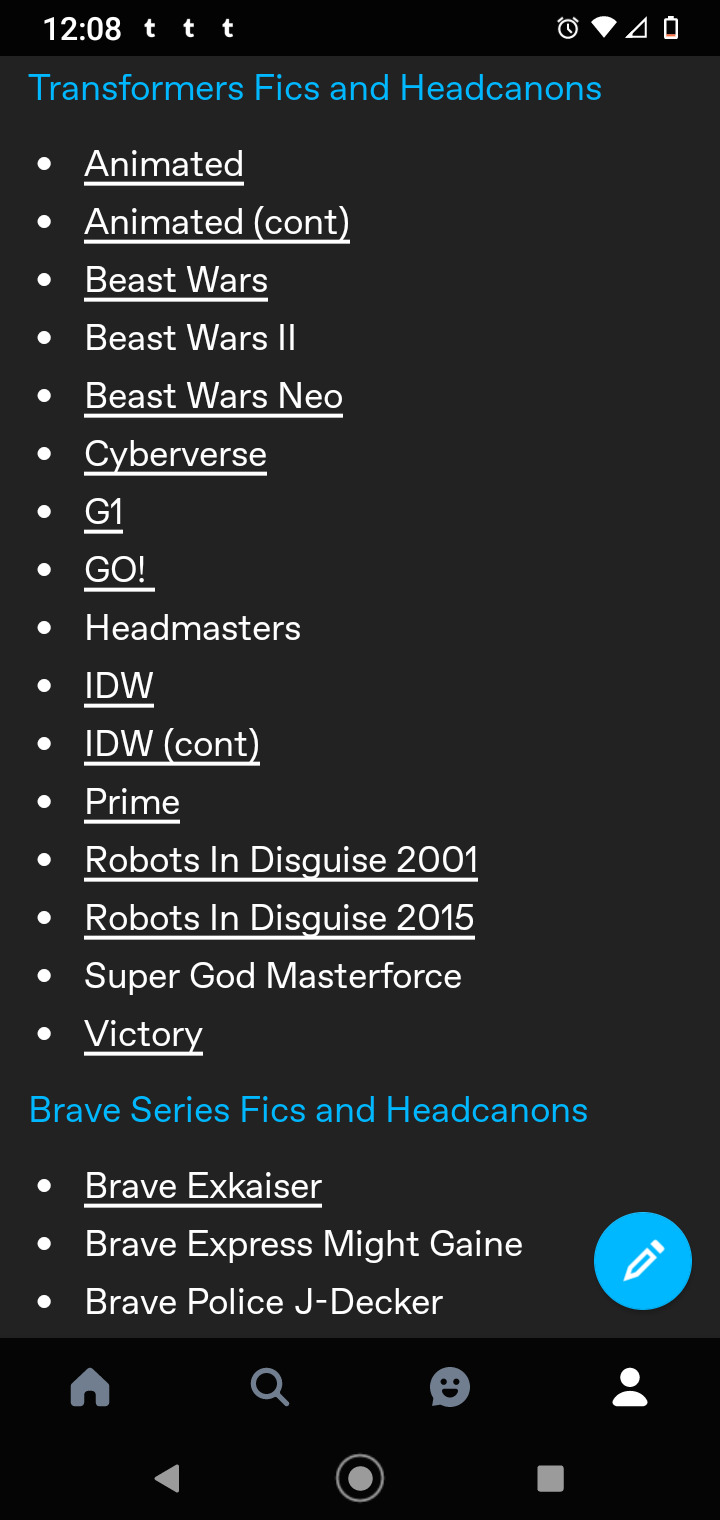
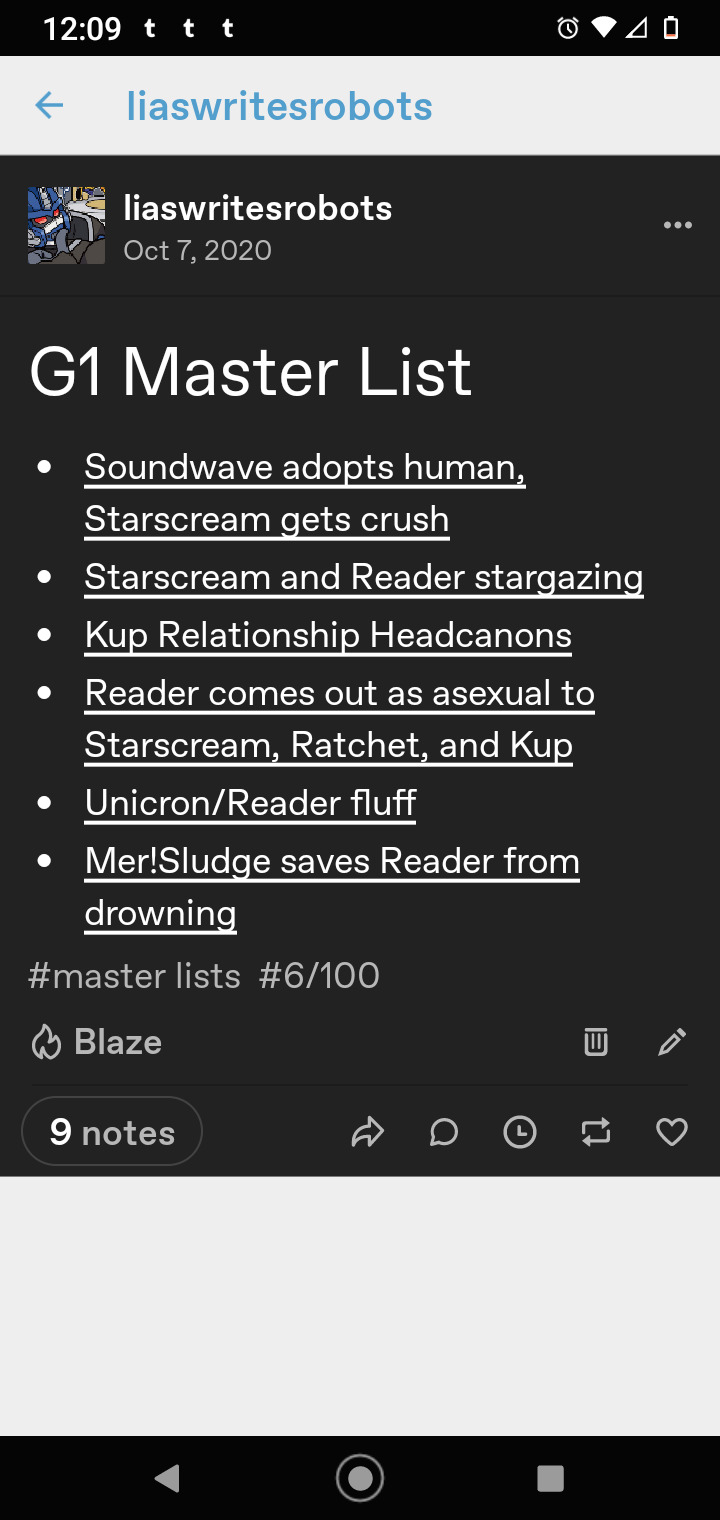
The first pic is the MASTER master list that lists everything I write for and when they're underlined like that it means they're links. The second pic is after clicking the G1 link, it's a separate post that has the actual fics and headcanon links. Note the 6/100 in the tags, this is how I keep up with how many things I've added. You can of course just use the numbers options from here

or just number them manually from your keyboard like I'm doing with this post. Adding links has no barring on what else you add to the post so you can add yourself some fancy header or divider pics if you want.
3. Adding links! Links can look like this https://www.tumblr.com/wingwaver/721887224846778368/test-post-for-reasons?source=share or like this https://wingwaver.tumblr.com/post/721887224846778368/test-post-for-reasons depending on whether you're linking from mobile or desktop/browser Just highlight the text you wanna add a link to and a the little chain will move to the end, click it and paste your url you want to link to and press add link, then press post/save draft/save (whatever the blue button says)

Now you've successfully linked a post to another post!
4. Tagging! To get your fics and headcanons seen to build an audience you usually wanna tag the stuff correctly. If you're posting a fic about Miles Edgeworth and Phoenix Wright from Ace Attorney then you'll tag it with #Ace Attorney, #Miles Edgeworth, and #Phoenix Wright in the tags area. But it's also a good idea to mention if it's a ship or general fic in the tags too. If so then putting ship names and #Miles Edgeworth x Phoenix Wright and #Miles Edgeworth/Phoenix Wright in the tags will help everyone know this is a ship fic. Tagging with characters or fandoms that aren't apart of the fic just clogs the tags for people looking for content of said characters and fandoms so it's very looked down on here and will likely get some of your stuff reported for spam so only use the relevant tags. Also tagging for triggers can be tricky here because of how fucky tumblr is but please don't tag censor tags. Tagging things like #a**** or #a*use or even #abu$e doesn't work here because people who have #abuse blacklisted will be able to see this content because it wasn't tagged properly. Also if you're writing for OCs or reader inserts it's common courtesy to tag those appropriately too. Someone looking for a reader insert may not want to read an OC and vice versa. Also many people filter those out so try to add tags like #x reader, #*fandom name* x reader, and #*character name* x reader for easier filtering. Also people cruise those tags too so it'll help people who fo want to read that content find your stuff!
#tumblr tips#writeblr#twitter migration#reddit migration#reddit blackout#twitter refugees#196#r/196#Twitter#Reddit#fanfiction#writing#writing blogs#tumblr help
438 notes
·
View notes
Text

Hey gang, it’s your old pal Neo here. If you know me, it’s probably from one of the several very stupid TF2 comics I’ve posted to Tumblr.
However! I am also an English major (unfortunately). One who has read millions of words worth of fanfiction in their life. I have been part of the Sherlock, BNHA, Disco Elysium, and, of course, TF2 fandoms; I’ve been around the block.
The further I’ve progressed into my English education, the more I’ve noticed which mistakes are the most common in fanfiction. Many of them are easily fixable; writers just need to be pointed in the right direction.
“Neo! Does this mean you think people shouldn’t be allowed to post their works online without a background in formal English education?”
Of course not! I can explain why if you’d care to venture below the cut with me!
Yes, I will explain how to use commas.
It’s important to note that this is NOT a post about formal writing. You aren’t writing an essay. Please, for the love of god, do not write fiction like you’re writing an essay.
There are no stakes to writing fanfic. No one is going to get hurt if an author doesn’t know what a dangling participle is. One of my favourite things about fanfiction is that it’s one of the only art forms left that’s done exclusively for fun! You should write what you enjoy, and share what you make with like-minded people.
What I want to do is provide assistance as best I can to writers who want to improve their fundamentals without having to take the same university courses I did. Nobody is going to be getting a formal education to write fanfiction unless they’re ridiculously dedicated, and I’m not expecting that of anyone.
The point I need to stress is that knowing these grammar fundamentals can instantly improve the flow of your writing. Punctuation is a ridiculously important tool for writers, ESPECIALLY in fiction. Commas, semicolons, and full stops (including periods, exclamation points, and question marks) steer the pacing in the reader’s mind; did you notice how your brain stopped for a second after that semicolon? I can show you how to do that.
You may be wondering why I’m going through so much effort to teach all of this to strangers on the internet. The answer is that I enjoy sharing this knowledge with others and helping them grow. By seeing this, my goal is to help you become more proficient at self-editing. Showing this to people who actually want to learn will, hopefully, benefit the community as a whole, and I think that’s very worth it.
Also, while this post is obviously themed around TF2, the points I’m making can be applied to any fiction. Grammar is for everyone, and the church of the semicolon always has room for more initiates.
Also also, as an edit, I should clarify that this is meant to cover the more objective facets of self-editing, which is why I'm mostly covering punctuation. Maybe I'll do another post about using adjectives someday.
With that out of the way, let’s get going!
I’ve teamed up with several English teachers (real ones! One of which may or may not be my mom!) and an editor to gather a list of the most common problems we see in amateur fiction. This post is going to be split into three broad sections: apostrophes, commas/semicolons, and other common problems.
The apostrophe
This section is short, but it holds weight. Other than commas, apostrophes are the most typoed grammatical tool in any fanfiction I’ve edited. This is because, much like the rest of English, the rules surrounding them can be annoying and inconsistent.
Apostrophes have two main uses: possessives and conjunctions.
A possessive is a word that denotes the ownership of one thing over another. The vast majority of the time, this is done using an apostrophe and an S.

There is, however, one glaring exception to this rule, and it’s the bane of my existence.
When denoting possession of an object over something else while using the pronoun ‘it,’ you do NOT add an apostrophe before the S.
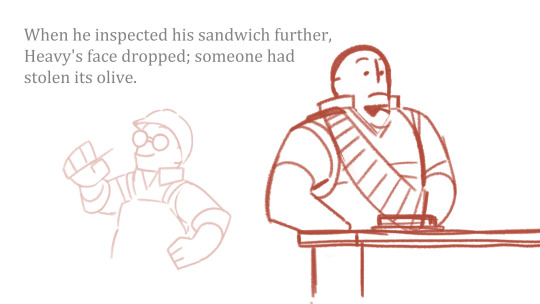
A conjunction, on the other hand, is when a writer uses an apostrophe to combine two words. The following are examples of common conjunctions:
What’s (what is)
They’re (they are)
It’s (it is)
Conjunctions are not often used in formal writing. Thankfully, we aren’t dealing in formal writing. Go crazy.
Time for a lightning round of the most commonly mistaken for each other possessives and conjunctions!
Your is possessive. You’re is a conjunction of ‘you’ and ‘are.’ When you can’t decide which one to use, imagine replacing it with ‘you are’ and seeing if it makes sense. If it doesn’t, use your.
Their is possessive. There indicates a location. They’re is a conjunction of ‘they’ and ‘are.’

The comma and the semicolon
You knew it was coming. I knew it was coming. It’s time to talk about commas.
Commas and semicolons are far and away the biggest grammatical hole in the toolset of fanfiction writers everywhere. They’re often treated like the rules surrounding them are complicated and difficult to understand, but the exact opposite is true!
The big issue I’ve heard time and time again is that the rules of commas are often explained through metaphor instead of example; this means that writers everywhere have slightly different ideas of how you’re supposed to use them. The fact of the matter is that, yes, there are correct and incorrect ways to use commas. Knowing when they’re appropriate and when they aren’t is easily the fastest way to bring your writing from looking amateurish to sounding professional and experienced.
In order to know how to use a comma, you must first understand the difference between a dependent and an independent clause.
An independent clause is a section of writing that functions perfectly well as its own sentence. It MUST have both a subject and an action/verb.
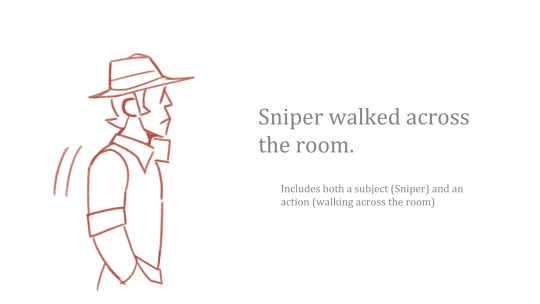
A sentence without an independent clause is known as a fragment, and they’re the bane of English teachers with highlighters everywhere.
A dependent clause is a section of writing that does not have both a subject and an action; it does not function as its own sentence.

Now, let’s say you want to combine the two. When joining a dependent clause to an independent clause, the order in which they are placed is crucial to whether you use a comma or not.
When joining a dependent to an independent with the independent clause first, you do not need to use a comma.

When joining a dependent to an independent with the dependent clause first, you MUST use a comma.
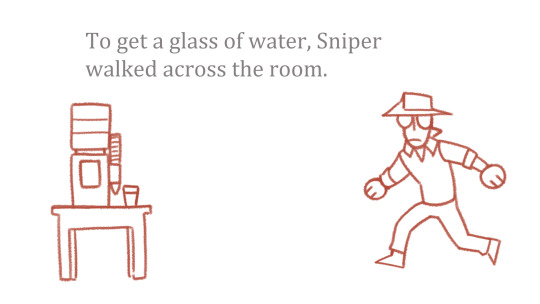
Keep in mind that, if one strives for total grammatical perfection, all narrative sentences MUST have an independent clause. This, however, does not apply to dialogue. Human beings do not think about whether what they’re saying is a dependent clause, and neither would the vast majority of fictional characters. Don’t be afraid to break the rules of grammar as long as it’s contained within quotation marks.
Alright, that’s the easy part. Time to learn about joining two independent clauses. It’s semicolon time, baby!
If you join two independent clauses without properly using a comma or a semicolon, it is a run-on sentence. You do not want these in your writing. They’re awkward to read and mess up the flow.

When joining two independent clauses, you can use EITHER a comma or a semicolon. You just need to follow these rules:
If you’re joining two independent clauses with a comma, you MUST use a joining word (and, but, so, etc.) AFTER the comma.

If you’re joining two independent clauses with a semicolon, you do NOT need to use a joining word.

Did you know that a sentence with a comma counts as its own independent clause? This means that you can make a sentence that includes a mix of both without it being a run-on! Just make sure that, no matter what, the semicolon is between two independent clauses.
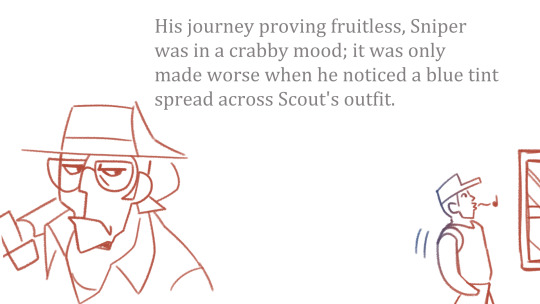
Still, try not to write more than two clauses in a sentence too often. Sentences with a lot of punctuation are very attention-grabbing, but shouldn’t be overused. Full stops aren’t your enemy and variety is the spice of life.
It’s also important to remember that you should avoid using more than one comma in a clause (with the exception of the rule below). That part loops back to the 'avoiding run-ons' bit.
It’s really that easy!
Commas are also used in informal writing to inject a separate thought or descriptor mid-sentence without breaking the flow by adding a period. This is often used when describing the perspective of a character experiencing something in a story, but not (usually) when using omniscient perspectives.

The final issue I frequently see with commas in fanfiction is in regards to dialogue. Sometimes you end it with them, and sometimes you don’t. What gives?
Well, my friend, the answer is, thankfully, much simpler than the previous section.
When following dialogue with a dialogue tag, use a comma instead of a full stop. If you’re continuing the previous sentence after the tag, use a comma after it as well.
Note that a dialogue tag is a short phrase that identifies the speaker. It isn’t a complete sentence on its own.

When following dialogue with an action that does not serve as a dialogue tag, use a full stop instead of a comma.
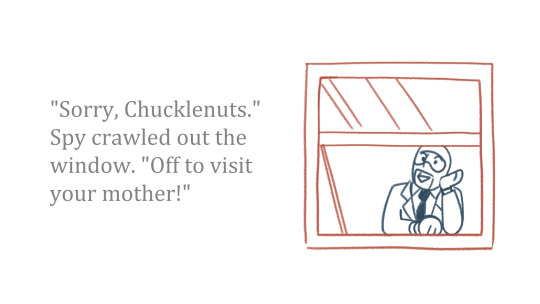
Other common problems
This section is dedicated to putting specific grammatical errors into words, along with how to solve them.
Not sticking to the chosen point of view
Always choose your point of view before you start. Is it in the first, second, or third person? Is it omniscient or limited? Does the point of view switch during the story?
First person perspective is told as if the POV character is directly describing their experience to the reader. The character uses I and we to describe their own actions.
Second person perspective is told as if the reader is a character in the story and their actions are being described to them. This is the rarest, and the most difficult to write.
Third person perspective is the most common and the simplest to write. The events of the story are a separate entity from the reader altogether and the narrator uses they/he/she/it pronouns for characters.
Omniscient perspective means the narrator of the story knows all, including the thoughts and feelings of each character.
Limited perspective means the narrator of the story only knows what the POV character knows.
Past and present tense
When you decide between writing a story in past or present tense, it is crucial that you do not switch between them unless it is narratively intentional. Reading a past tense story that mistakenly switches to the present tense is like being pulled out of the room someone is telling a story in and suddenly taking part in it yourself. It’s disorienting and gives the reader unwanted pause.
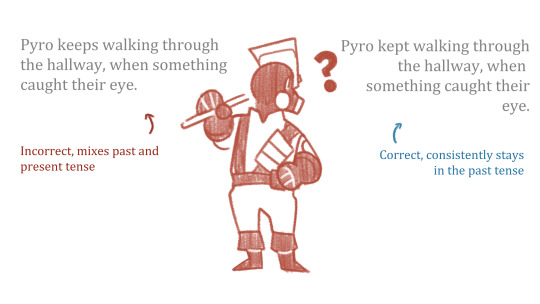
Overly-long paragraphs
A common adage spread by English teachers is that most paragraphs should be at least eight sentences long. This is great advice for beginner essays. You’re writing fiction.
If you have a new thought, start a new paragraph! A concise and well-read single-sentence paragraph is infinitely better than one that drags a thought for too long. Aim to have a blend of paragraph lengths when you write, alternating between the descriptive and the punctual.
Dangling participles
A dangling participle is when a word is used to describe a noun that isn’t actually present in the sentence. Much like how a sentence without an action isn’t grammatically correct, neither is a sentence without a subject.
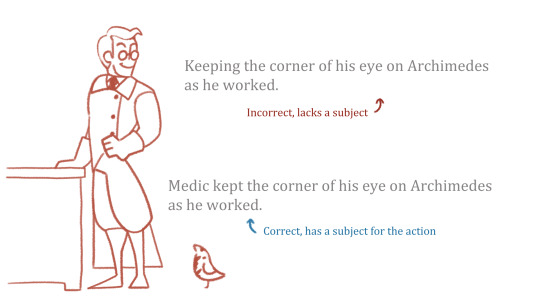
Malapropisms
A malapropism is when an author mistakenly uses one word or phrase instead of another similar-sounding one. I’m not about to list every single malapropism ever made, but these are the ones I notice most often:
To comprehend is to understand something, to apprehend is to arrest someone, and to be apprehensive is to be anxious or fearful of something bad happening.
Could care less means you do care. Couldn’t care less means you don’t.
A lot means a large amount of something. Alot isn’t a word and you shouldn’t use it.
The only real solution to using malapropisms is to make sure you fully understand any words you use in your writing. Never guess, and make sure you always google it. Having beta readers also helps.
If you made it this far, congratulations! You now know the most common errors in amateur fiction and how to solve them! Thank you for listening to me complain for two thousand words.
The most important thing to remember is that it’s okay to make mistakes. First drafts are always gonna be a little bad. The real key to success is knowing what your end goal is, and how you plan on achieving it. Here’s hoping this was a helpful tool for that!
Shoutout to @salmonandsoup for helping me think of the list of issues to address! You're a real one. Also shoutout to my mom, who doesn't have Tumblr. Also the third person. You know who you are.
#grammarposting#tf2#grammar#educational shitpost#writing#fanfic#fanfiction#writing advice#fanfiction writing advice#team fortress 2#tf2 fanfiction#bro your participle is dangling
223 notes
·
View notes
Text
Image Descriptions and Accessibility in General on Tumblr for New Users
What are Image Descriptions
Image Descriptions are text following a picture explaining what’s in that picture. They are primarily for blind/visually impaired people with screen readers and visually impaired people who can read text but have issues with pictures.
They also help people who have trouble:
focusing on/understanding a picture
reading text on images (ex low contrast, weird fonts, etc)
getting images to load
Without image descriptions posts are not accessible to many people, so if you can it's best to include a description or alt text every time you post an image.
Alt text vs image descriptions
Image descriptions are written in the body of the post itself, and have some kind of text before and after, to explain that what's coming up. They typically begin short and concise, but can expand to more detail.
Alt text is added to the image itself, and is what is read by screen-readers (which will otherwise just say "image"). There is no need to add any explanation before the description so you can just say "a description of the image". Alt text can only be added by the original poster, by clicking on the three dots in the bottom right corner of the image and clicking 'update image description.' It is typically short and concise.
On tumblr, alt text is currently available on web by clicking on the alt button (or via new xkit - accesskit - move alt text to captions below image). On mobile, alt text is available in some versions of the app through clicking on the alt text button. Image descriptions are visible on all posts, although if you put them under a read-more, that makes them less accessible. (Thanks to @911described for helping with this section)
How to Make Image Descriptions
Awhile ago I made this general guide. I learned from examples, so here are descriptions made by a bunch of different people. I've also made templates for a lot of common images you'll see on Tumblr.
Other Concerns
Gradient or all caps text make most screen readers read out the word one letter at a time. In addition, these plus text that is bold/italicized/underlined, in colors other than black, or in weird/fancy fonts are difficult for many people to read.
How Filtering Works
You can filter out both words/phrases and tags in the filtering section under the general section in the settings. When filtering out words from a post, it will look at both the text of the post/reblog chain and at the url of op and the rebloggers. When filtering out tags it will look at the tags of the specific post on your dash, and at the tags of the original post.
Tagging for Common Triggers
Don't sensor trigger warnings (for example don't tag suic!de) because then people who have them filtered will still see it.
Tagging for Flashing Lights
If you post a gif or video in a post that flashes, you should tag it with something like "flashing lights" and Not "tw epilepsy" because if any of the tags in the original post contains the world epilepsy it will show up in the epilepsy tag, which is dangerous. Check out this post from @photosensitive-despair for more info about tagging photosensitive content.
Tagging for Unreality vs Misinfo
Things that could trigger delusions/psychotic episodes/etc should be tagged with unreality. This includes:
content that has existential themes related to reality/things not existing (example: a philosophy such as solipsism, do not look up the term if unreality stuff is triggering for you)
extremely surreal content(example: sometimes content such as weirdcore/dreamcore aesthetics can fall under this umbrella but again this is very subjective)
content that reinforces or encourages common delusions(example: that one "im living in your walls" meme)
Things like rp blogs and fake/edited tweets should not be tagged with unreality, unless they contain triggering content. Consider tags like "fiction" or "misinfo." See this post for more info.
Edit:
Addition from @mindflamer
You can look through the reblogs of a post to see if someone's already written a description. There is a button to see just comments vs. comments + tags which makes it easier. Scroll through looking for brackets [], ID, or Image Description. This is great to do if you can't write your own IDs for whatever reason, so that you can at least spread the version of the post that's described if there is one.
If you're not able to write IDs consistently, some is better than none. Don't let the perfect be the enemy of the good. You can use the tag #undescribed to make it easy for those who need them to filter out those posts. Similarly, if you primarily tag triggers but can't for certain posts, you can use a separate tag on that to be filtered such as #untagged.
Please, if I forgot something, sound off in the notes and I'll update this post with it
398 notes
·
View notes